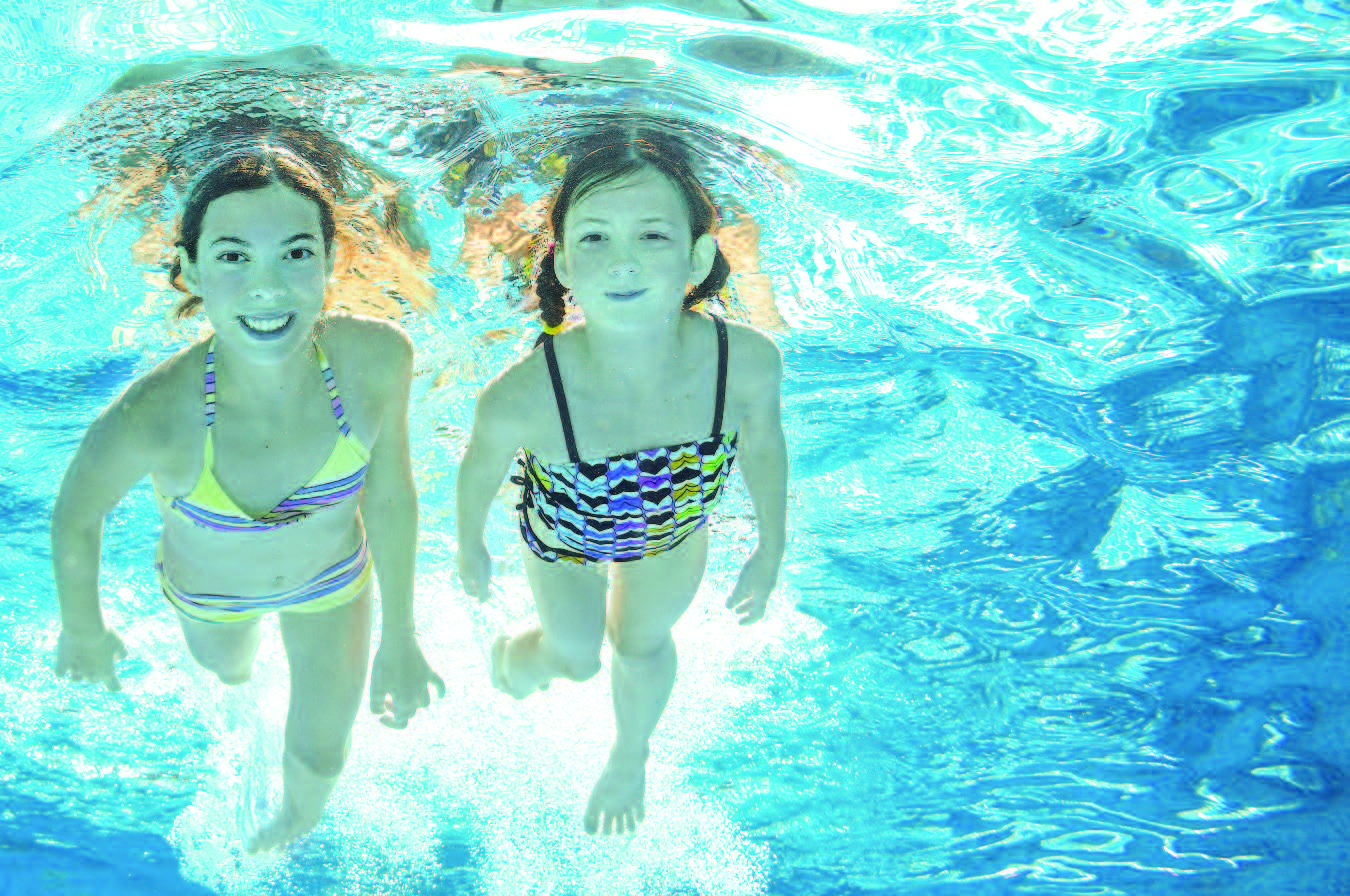EDGE takes you inside the area’s most creative kitchens.
 Paragon Tap & Table • Homemade Italian Sausage with Herb Risotto and Heirloom Tomatoes
Paragon Tap & Table • Homemade Italian Sausage with Herb Risotto and Heirloom Tomatoes
77 Central Ave. • CLARK
(732) 931-1776 • paragonnj.com
I have created a hearty dish that represents the Craft Experience that Paragon Tap & Table is known for. My winter menu also features street fair tacos, steamed selection, award-winning burgers and of course creative and seasonal large plate entrees.
— Eric B. LeVine, Chef/Partner
 Arirang Hibachi Steakhouse • Wasabi Crusted Filet Mignon
Arirang Hibachi Steakhouse • Wasabi Crusted Filet Mignon
1230 Route 22 West • MOUNTAINSIDE
(908) 518-9733 • partyonthegrill.com
We prepare a crusted 8-ounce filet mignon served with gingered spinach, shitake mushrooms, and a tempura onion ring.
 Daimatsu • Grilled Oyster
Daimatsu • Grilled Oyster
860 Mountain Ave. • MOUNTAINSIDE
(908) 233-7888 • daimatsusushibar.com
Fresh jumbo Pacific oyster grilled with homemade miso sauce, fried northern puffer fish marinated in light ginger soy coated in potato starch, with deep-fried crunchy veggie on the side.
— Momo, Chef
 Publick House • Publick House Rigatoni
Publick House • Publick House Rigatoni
899 Mountain Ave. • MOUNTAINSIDE
(908) 233-2355 • publickhousenj.com
It’s cold outside and our rigatoni pasta with braised short ribs is the perfect entree to warm up to. Short ribs are a labor of love, but seeing the customer’s face light up after the first bite makes the process worth it. The rigatoni and short rib are enhanced with sautéed kale and stewed tomatoes, and finished with creamy, herbed ricotta.
— Bernie Goncalves, Owner
 Luciano’s Ristorante & Lounge • House Made Mafalda Pasta Inverno Style
Luciano’s Ristorante & Lounge • House Made Mafalda Pasta Inverno Style
1579 Main Street • RAHWAY
(732) 815-1200 • lucianosristorante.com
Our goal is to give our guests a pleasurable dining experience, with fresh ingredients and personable service in a beautiful Tuscan décor complete with fireplaces. Our house-made Mafalda pasta features slow-braised artichoke crowns, cipollini onions and oven-dried tomatoes in a saffron cream broth. Luciano’s is available for dining and private parties of all types.
— Joseph Mastrella, Executive Chef/Partner
 Costa’s Italian Ristorante & Catering • Paglia Fieno Mimosa
Costa’s Italian Ristorante & Catering • Paglia Fieno Mimosa
120 Chestnut Street • ROSELLE PARK
(908) 241-1131 • costasitalianrestaurant.com
Our Paglia Fieno Mimosa features spinach and egg fettuccine in a brandy cream sauce with peas, mushrooms and prosciutto.
— Nicola & Brian, Hosts
 Spirit: Social Eatery and Bar • Double Cheddar Infused Burger
Spirit: Social Eatery and Bar • Double Cheddar Infused Burger
250 Morris Ave. • SPRINGFIELD
(973) 258-1600 • mclynns.com
It doesn’t get better then a double cheddar infused burger from the new Spirit: Social Eatery and Bar.
— Mark Houlker, Chef
 Arirang Hibachi Steakhouse • Volcano Roll
Arirang Hibachi Steakhouse • Volcano Roll
23A Nelson Avenue • STATEN ISLAND, NY
(718) 966-9600 • partyonthegrill.com
Hot-out-of-the-oven, crab, avocado and cream cheese rolled up and topped with a mild spicy scallop salad.
 Galloping Hill Caterers
Galloping Hill Caterers
Galloping Hill Road and Chestnut Street • UNION
(908) 686-2683 • gallopinghillcaterers.com
Galloping Hill Caterers has been an incredible landmark for nearly sixty years. We pride ourselves in delivering “over the top” cuisine, impeccable service and outstanding attention to detail. That is the hallmark of our success! Simply, an unforgettable experience. Pictured here is one of our crepes flambé that really creates lots of excitement!
— George Thomas, Owner
 The Barge • Cioppino
The Barge • Cioppino
201 Front Street • PERTH AMBOY
(732) 442-3000 • thebarge.com
Our Cioppino, the signature dish of San Francisco, features a fresh, healthy selection of clams, mussels, shrimp, Maine lobster and Jersey scallops—drizzled in Greek virgin olive oil, with fresh garlic and white wine—over homemade Italian linguini. I know it will become one of your favorite dishes.
— Alex Vosinas Chef/Owner
Want to know how your BEST DISH could be featured in our Chef Recommends restaurant guide?
Call us at 908.994.5138
Laughter may be the best medicine… but in Tinsel Town medicine isn’t always a prescription for laughter.
By Mark Stewart
There is nothing inherently funny about doctors and hospitals. Their business is deadly serious, no pun intended. Perhaps that is why, over the past century, Hollywood has churned out just a handful of feature-length medical comedies—and why the good ones are truly few and far between. Television has had somewhat better luck with this genre. Half-hour sitcom scripts don’t leave room to delve too deeply into the grim reality of trauma and illness, enabling a show like Scrubs to bang out nine successful seasons. Even so, it’s worth noting that the show’s main plot device was to explore the daydreams of Zach Braff’s character, Dr. Dorian. His reality?Not so much.
The best medical sitcom, by almost any measure, was M*A*S*H*. It lasted 256 episodes over the course of 11 seasons thanks to a superb ensemble cast and a stable of thoroughbred television comedy writers. More than 125 million viewers tuned in for the final episode in 1983. That was before anyone had a DVR and, speaking purely from personal experience, before most folks figured out how to program their VCRs.
So it should come as no surprise that the film that tops the list of all-time Top 5 medical comedies is that very same anti-war doc-pic. What do the five movies have in common, other than their watch-ability? Not a one actually takes place in a traditional hospital setting.
Interesting, don’t you think?

20th Century Fox
1) MASH (1970)
The concept was deliciously brilliant: Use the Korean War to make a biting mainstream satire of the Vietnam War. Director Robert Altman cast some of the top young actors of the day in the now-iconic key roles: Donald Sutherland (Hawkeye), Elliot Gould (Trapper John), Robert Duvall (Major Burns), Tom Skerritt (Duke) and Sally Kellerman (Hot Lips). Their understated performances coupled with the gritty cinematic style of Harold Stine gave this film a gripping reality that made the subversive, anti-authority wit and humor scalpel-sharp. And yet it was silly when it had to be. MASH won the grand prize at Cannes and went on to earn the Golden Globe for Best Picture and five Academy Award nominations, winning an Oscar for Ring Lardner Jr.’s adapted screenplay of Richard Hooker’s 1968 novel.
Little Known Fact: The lyrics of the movie’s (and TV show’s) theme, “Suicide is Painless,” were written by Mike Altman, the director’s 14-year-old son. Mike made more from the song’s royalties than his dad did for directing the film.
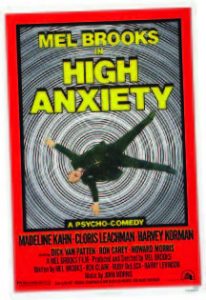
20th Century Fox
2) High Anxiety (1977)
After his runaway hits Blazing Saddles and Young Frankenstein, Mel Brooks took on suspense thrillers for his next parody, High Anxiety. His character, Dr. Richard Thorndyke, starts a new job as head of the Psycho-Neurotic Institute for the Very Very Nervous. We know something’s not quite right at the Institute when he meets his staff, which includes Cloris Leachman and Harvey Korman, two of the great comic kooks. Thorndyke suffers from vertigo, one of many tips of the hat to Alfred Hitchcock, including an unforgettable scene inspired by The Birds. He must overcome his affliction to save his love interest, played by Madeline Kahn. The shower scene from Psycho is also parodied.
Little Known Fact: Mel Brooks actually worked with Alfred Hitchcock on the screenplay for High Anxiety. After the film was released, Hitchcock sent Brooks a case of 1961 Chateau Haut-Brion.
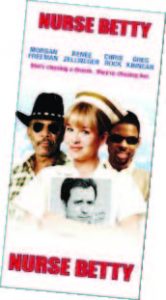
USA Films
3) Nurse Betty (2000)
The charm of this comedy—besides the spot-on performance of Renée Zelweger in the title role—is that it is utterly unpredictable and follows its own rules. That’s a tribute to Neil LaBute, a playwright-turned-director who maximized the skills of an eclectic cast that includes Morgan Freeman and Chris Rock (as ruthless hit men), Aaron Eckhart (as a sleazy car salesman), Allison Janney (as a Hollywood producer) Crispin Glover (as a small-town newspaper reporter), and Greg Kinnear (as a soap opera doctor). After witnessing the murder of her husband, Betty enters a fugue state and becomes a character in her favorite daytime drama, A Reason to Love. Kinnear’s send-up of a shallow, self-absorbed Hollywood actor is priceless. Zelweger won a Golden Globe for her work.
Little Known Fact: Wizard of Oz fans who spotted references to the 1939 film in Nurse Betty weren’t imagining things. Production designer Charles William Breen said he was inspired by the classic movie, and Renée Zelweger clearly channeled Dorothy in her portrayal of Betty.
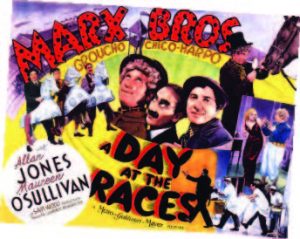
Paramount Pictures
4) A Day at the Races (1937)
Author Norman Cousins (a New Jerseyan, for what it’s worth) famously cured himself of ankylosing spondylitis with mega doses of vitamin C and a steady diet of Marx Brothers movies and other comedies. A Day at the Races is considered one of the brothers’ best. Standish Sanitarium faces ruin when Mrs. Emily Upjohn, its wealthiest patient, is deemed sane enough to be discharged. Enter Dr. Hugo Hackenbush (Groucho Marx), who is hired as Chief of Staff to personally treat Mrs. Upjohn. Hackenbush is actually a veterinarian, but Harpo and Chico help him escape detection. Meanwhile, the fate of the sanitarium hangs on the performance of a racehorse named Hi-Hat, piloted by Harpo in a wild final ride.
Little Known Fact: Many of the movie’s best scenes—including the classic Tutsi-Fruitsy Ice Cream exchange between Groucho and Chico—were perfected on the Vaudeville stage by the Marx Brothers in the months prior to filming
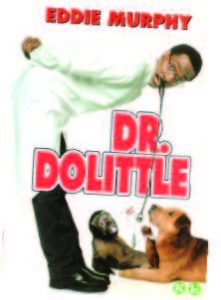
20th Century Fox
5) Dr. Dolittle (1998)
Eddie Murphy plays John Dolittle, a San Francisco physician who had the ability to talk to animals as a boy. But that was then and this is now—he’s a family man and partner in a lucrative practice that’s about to be sold for big bucks. A bump on the head restores Dr. Dolittle’s unusual powers, and he begins communicating with a sarcastic dog (voiced by Norm McDonald), a sassy guinea pig (voiced by Chris Rock), a wounded tiger (voiced by Albert Brooks) and a variety of other creatures. The movie got a PG-13 rating for its ceaseless scatological humor, but was marketed by 20th Century Fox as a family film. Among the other voices you’ll recognize are Jenna Elfman, Gilbert Gottfried, John Leguizamo, Julie Kavner, Garry Shandling, Paul Reubens, Ellen DeGeneres and Brian Doyle-Murray.
Little Known Fact: The late-1990s marked the beginning of Eddie Murphy’s transition from movies aimed at adult audiences to family-friendly fare. The Nutty Professor (1996), Dr. Dolittle and Shrek (2001) revived his box office power. In 2007, Murphy won a Golden Globe and was nominated for a Best Supporting Oscar for playing R&B star Jimmy Early in Dreamgirls. EDGE
SHORT STUFF
Two of history’s most uproarious medical comedies were 18-minute “two-reelers” that were screened between the main movie-house features. Interestingly, both were set in traditional hospitals.
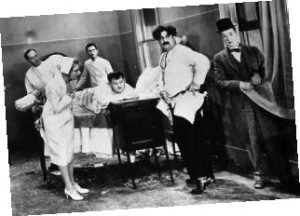 In County Hospital (1932), Stan Laurel plays the all-time worst hospital visitor, arriving in the room of Oliver Hardy, who is in traction with a broken leg. Billy Gilbert, whose mere appearance on the screen generated peals of laughter in the 1920s and ’30s,
In County Hospital (1932), Stan Laurel plays the all-time worst hospital visitor, arriving in the room of Oliver Hardy, who is in traction with a broken leg. Billy Gilbert, whose mere appearance on the screen generated peals of laughter in the 1920s and ’30s,
plays Ollie’s doctor. He throws them both out after a near-death experience.
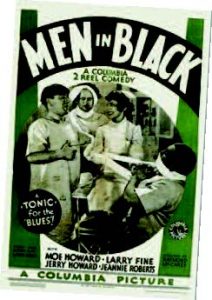
Columbia Pictures
If the Three Stooges turn you on, Men in Black (1934) is one of their most important short films. Larry, Moe and Curly play a trio of doctors who graduate from medical school with the “highest temperatures in their class.”
The boys received their Columbia Pictures lone Oscar nomination for Best Short Comedy for Men In Black, which was meant to be a spoof of Men In White, a serious film starring Clark Gable and Myrna Loy.
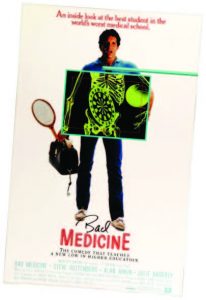
20th Century Fox
NOT THAT BAD
Steve Guttenberg fans will argue that Bad Medicine (1985) should sneak into the Top 5 and they may have a point. Guttenberg plays a slacker who attends medical school in Central America and finds himself—both as a doctor and a solid citizen. The school is run by autocratic Alan Arkin and the students learn more from Marcus Welby reruns than from their professors. A fun movie that was largely ignored at the box office and video rental stores…hey, remember video rental stores?
EDITOR’S NOTE: An unnamed EDGE staff member suggested that Mother, Jugs & Speed be reconsidered as a Top 5 medical comedy for this story. He is no longer permitted to speak at editorial meetings. Mark Stewart has authored two “Top 10” books on film: Ultimate 10 Movie Blockbusters and Ultimate 10 Movie Characters, both in 2009.
Count on summer camps to build aquatic competence in your child.
By Christine Gibbs
New Jersey can proudly boast of more than 200 lakes, about 240 rivers, and countless ponds, streams, and creeks. And that’s before you get to the 100-plus swimmable miles of Jersey Shore between Sandy Hook and Cape May. New Jersey can also lay claim to a good percentage of the 10.4 million residential and 309,000 public swimming pools in the US.
With such a plethora of fresh and saltwater options, the urge to go swimming, sailing, canoeing, kayaking or simply splashing around can be overwhelming.
Unfortunately, it’s not always fun and games. Water safety or, more accurately, water competence is a vital part of a lifelong enjoyment of all things wet and wonderful. Consider the following statistics, which come from Psychology Today:
- Two-thirds of Americans are afraid of deep, natural bodies of water
- 37 percent of Americans are unable to swim
- Almost 4,000 people a year in the United States die from drowning
- 46 percent are afraid of the deep end of a pool
According to CDC statistics, about one in five drowning victims is 13 or younger. Needless to say, water competence is something parents need to instill in their kids at the earliest possible age.
Which is where summer camps come in. A sleep-away or day camp with first-rate aquatic programs and facilities is worth all the extra time and trouble to find, and every extra penny you might have to shell out to build confidence in your kids when it comes to interacting with the water.
Some children seem to emerge from the womb with a love for water. It’s evident from their very first bath. Others not so much. They are burdened with an irrational fear of water, which sometimes originates with their parents’ own fears or insecurities. Wherever it comes from, it can make learning how to swim a seemingly insurmountable challenge. That being said, there are long-established methods for encouraging self-confidence in children who have none, and also to temper any potential overconfidence in more reckless young water enthusiasts. The key is to foster respect for the water at the same time you’re building trust and a sense of security. This is a job best left to the professionals. Parents don’t always make the best swimming teachers. In a summer camp environment, you have trained instructors, lifeguards, other kids to learn with and long-established water culture.
In sorting through summer camp options, make sure you understand what type of water activities each camp offers. In some cases, it’ll be all about the water. In others, a water sport may simply be one of many activities. Whatever you’re drawn to, ask questions about instruction, supervision, and goals. Ideally, you want a camp where the owners/directors and counselors are professionally equipped and personally committed to turning even the most reticent young guppy into a fearless shark. The seven summer camps in these pages are all a little different, but share stellar reputations for their aquatic programs.

Adirondack Camp
Adirondack Camp
Putnam Station, NY
Co-ed 7 to 17
adirondackcamp.com
Situated on Lake George, “ADK” has roots that run back to 1904. It offers kids two to eight weeks of challenging activities and the opportunity to make new friends from far-off places (20% of the camper population is international).
The camp is surrounded on three sides by the lake. According to Waterfront Director Ryan Harrell, ADK is “the perfect place to go canoeing, wakeboarding, stand-up paddleboarding, windsurfing, sailing, and kayaking. Because we’re on a natural peninsula, activities are not separated one from the other. Although the psychological effect of being in a natural water environment can be intimidating, the various conditions—ranging from deep water to a shallow sandy bottom in our Junior Cove—help to gradually build confidence and fight fear. We work step-by-step and stroke-by-stroke with each child. We strive to keep a safe environment to get our kids to take healthy risks. Our goal is growth through building self-awareness and self-confidence…nothing is more real-world than being on the water.”
As is the case with pretty much all camps located on significant bodies of water, ADK’s kids must take a swimming test when they arrive and participate in appropriate-level swimming lessons (certain activities like canoeing, wind surfing, and kayaking require varying levels of swimming competency). According to Shawn Carraher, a member of the owner’s family, beyond its aquatic program, ADK has a decidedly traditional camp philosophy that “provides an opportunity for campers to develop confidence and leadership skills, and to discover a sense of themselves—all under the guise of having fun.”
From the owners and directors down to the counselors, the focus, adds Carraher, is on understanding the whole child and treating each as an individual. Counselors bunk with the campers and receive pre-camp training in how to get in touch with their charges to help them through any issues or anxieties, such as homesickness or aqua phobia. And although swimming is at the core of the waterfront program, the emphasis is on gradually branching out into the more challenging activities.
Camp Cayuga
Honesdale, PA
Co-ed 5 to 15
Campcayuga.com
Camp Cayuga is located on a secluded 350-acre estate in the Pocono Mountains, which features a junior and senior campus. The camp season is organized into nine different
sessions, ranging from two- to eight-week stays. In all, nearly 400 children from three dozen states and more than a dozen countries attend. The Cayuga staff numbers about 175, so no camper is lacking for supervision or attention.
Much of the activity takes place in or around the property’s 13-acre lake, which features 250 feet of beach, a sand volleyball court, a boathouse, a floating raft with a water slide and a separate fishing dock. According to Director Brian Buynak (a second-generation family owner), Camp Cayuga’s Waterfront Program meets all standards and guidelines of the American Red Cross, as well as the American Camping Association (ACA). The Water Program is under the management of two Waterfront Directors who have a staff of 8-10 fully-certified instructors and lifeguards.
Assistant Director Marcus Whitehurst adds that the water program includes three pools that are used for swimming instruction and recreational activities, including water polo and scuba diving clinics. All campers are required to take a swim test and the younger campers are required to take swimming instruction. Most campers arrive with some level of swimming competence, but all participation in water activities is elective (except for the swimming instruction, if needed).

Camp Riverbend
Camp Riverbend
Warren Township, NJ
Co-ed 3 to 14
campriverbend.com
Camp Riverbend, a family-owned and operated day camp, is celebrating its 56th anniversary this year. As its name implies, the property is situated at a bend in the Passaic River in Somerset County. This location is ideal for campers to learn the fundamentals of safe canoeing and kayaking, all under the guidance of certified camp instructors. Swimming is not allowed in the river itself, so campers spend a lot of time around Riverbend’s four swimming pools.
Water Director Robin Breene Hetrick—one of the family owners with 30 years of swim teaching experience—is in charge of managing the swimming program (which includes 18 other instructors) and also seeing that the pools are kept clean, safe, and crystal-clear at all times. The average 750-850 weekly campers are grouped by age and then by swimming ability. The four pools are constructed with 11 inches of water at the low end to accommodate even the youngest campers, who are gradually encouraged to float with face in water, the first step in gaining aquatic confidence.
For the older campers there is an instructional swim every morning and a free swim in the afternoon. Small swim groups are organized by competence (not age), which is assessed on a regular basis by swim evaluations. According to Hetrick, the word “test” is never used. “Instead we just ask the child to show me what you can do,” she says. “Camp Riverbend is all about participation, not competition. We believe there’s too much competition in everyday life, so we want our camp to be a place to escape from pressure. We are hands-on, watchful and supportive. We treat learning to swim just like learning to walk—in gradual stages with an emphasis on improving self-awareness and taking pride in self-improvement.”
Camp Wicosuta
Hebron, NH
Girls 6 to 15
campwicosuta.com
Established in 1920 as one of the region’s first sleep-away camps for girls, Camp Wicosuta boasts a long tradition of morale- and spirit-boosting activities for up to 300 campers in each of its two four-week summer sessions. The web site states that the “goal is for every child to walk away feeling confident,” and it aims to get kids to surpass “their self-set limits.” Wicosuta is a Native American word meaning strength of mind and body.
Camp Director Justin Dockswell says Wicosuta is serious about “our philosophy of the Three C’s—Confidence, Competence and Community. That’s what our staff is dedicated to inspiring in every camper at every age level.” That applies to the aquatic program, which is built around Newfound Lake, which is ranked #7 in a survey of US lakes conducted by USA Today and cited as “one of the cleanest and clearest lakes in America” by National Geographic Magazine.
Camp Wicosuta also has a swimming pool on its campus, which makes the instructional portion of the camp’s water program more inviting, especially since the pool is comfortably heated. Daily swim lessons are required for girls in Grades 1-4, while older girls can work on American Red Cross badges. For more excitement and challenges, girls with the required competency can move onto the lake for training in activities such as canoeing, kayaking, waterskiing, kneeboarding, wakeboarding and sailing. Other lake activities include boat rides, tubing, and a water trampoline. Dockswell estimates that 80 to 85 percent of the camp’s activities involve the lake or pool. Although after Grade 5, campers make elective choices among available activities, water-related options are always the most popular.
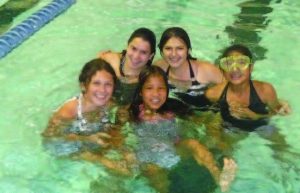
Campus Kids
Campus Kids
Blairstown, NJ
Co-ed • 7 to 15
Campuskids.com
The region’s only weekday sleep-away camp is located on the campus of Blair Academy. Children are picked up in an air-conditioned coach on Monday mornings and returned to their families Friday nights. Each day, campers select their activity for the next day, with programming covering sports, fine arts and performing arts along with other traditional camp activities.
The camp’s pool is indoor and heated, which makes it a popular choice. Every child’s water competence is evaluated the first day, and there are daily swim lessons for every camper under the age of 13, grouped by similar ability. “The pool is also very popular for recreational swimming, as well as evening activities and special events,” says Director Tom Riddleberger, who started Campus Kids in 1991.
The Campus Kids bus fleet does pick-ups from various collection points in Northern and Central New Jersey, and from Manhattan, Rockland and Westchester. Sessions run from two to seven weeks, with about 200 campers in session at a given time.
Valley Forge Military Academy Summer Camp
Wayne, PA
Overnight Boys 9 to 17
Co-ed Day Camp 6- to 17
vfmac.edu/academy/summer-camp
Valley Forge Military Academy, (VFMAC), has a long tradition steeped in instilling values and building self-confidence to prepare tomorrow’s leaders. Not surprisingly, the Academy also offers a rigorous summer camp for both day and overnight campers. The summer camp is run by Elizabeth Wahlberg, Director of Student Activities and Summer Camps, who says the summer sessions reflect the time-honored tradition that has made the Academy itself into such a revered institution. The camp focuses on self-improvement, fitness and leadership, with programs ranging from academic enrichment to physical training. The flavor at sleepover camp is distinctly military (kids sleep in barracks and dine in the mess).
Among VFMAC ’s water-oriented offerings (for both day and sleepover campers) is a specialized scuba diving course. This popular program is conducted by Ultimate Scuba Adventures, a full-service diving center located in Media, PA. The center is certified by the International Professional Association of Diving Instructors (PADI) and the camp program is overseen by Ultimate’s owner, André Horne. Scuba groups at the VMAC camp consist of about a dozen students ranging in age from 10 to 16, all of whom have provided waivers covering medical, liability and parental permission. Each group is supervised by two instructors and a Dive Master, who is responsible for overall pool conditions and safety measures.

www.istockphoto.com
The scuba program is conducted twice each season and is considered to be a Discover Scuba opportunity as opposed to a full-fledged diving course. Each scuba program consists of four 3-hour sessions: 1) orientation, 2) initial diving exercises [e.g., mask clearing, mask recovery], 3) introductory games to develop flexibility and confidence underwater, and 4) a final series of exercises to be conducted for the first time at the deep end of the pool.

www.istockphoto.com
William Lawrence Camp
Center Tuftonboro, NH
Boys 8 to 15
wlcamp.org
William Lawrence Camp offers an active waterfront program on its half-mile frontage along Lower Beech Pond, which includes swimming and fishing areas. The camp also boasts a small fleet of sailboats, canoes, kayaks and rowboats, as well as a competition water-ski boat. Campers must pass various levels of American Red Cross swimming instruction to progress to the more challenging water activities. Executive Director Nat Crane emphasizes that, despite the popularity of WLC’s water program, it is only a part of the larger camp focus on overall wilderness skills, and keeping boys physically active and personally challenged—including riflery and archery. It’s a perfect blend of exuberance tempered with serious self-improvement, Crane maintains.
“Campers are exposed to an environment that is often the opposite of what they have at home,” he says. “They develop a great sense of community, a tremendous spirit, and a responsibility for themselves and others.”
WLC is more than a century old and differs from the competition in that it’s set up as a not-for-profit, with all funds raised funneled back into the camp. This lowers the cost of the summer program, which runs seven weeks (divided into three- and four-week sessions). The staff to camper ratio is 2:1, and more than three-quarters of campers typically return the following summer.
When choosing a camp—whether water competence is your highest priority or not—your number-one job as a parent is to know your child. This means accepting your child’s level of physical development and emotional maturity, along with an awareness of his or her personal preferences. There are the basic questions: Is your child ready for a sleepover camp or would a day camp be preferable? Would your child like to be near to home or prefer an adventure farther afield? Is your child a natural water rat or a no way/not me water baby? In terms of a camp’s water program, don’t just go by the pictures on the web site or brochure. Look at reviews and comments from other parents. Call and ask questions, too. Find out what water safety regulations are in place, and what kind of swimmers attend the camp. And obviously, look at a camp’s other programmed activities and make sure they relate to your child’s interests.
Once all these questions have been answered, the final and best choice should become much clearer. That leaves only two catches—does it fit in your budget and is space still available? Generally speaking, there are camps to fit every pocketbook. But the best ones tend to book up quickly, so if you haven’t begun your search at this point you may have to hustle.
As a final footnote, be ready to be proud. If you’ve done your homework and made the right choice, you might not recognize the child you pick up from camp as the same one you dropped off.
START ’EM YOUNG
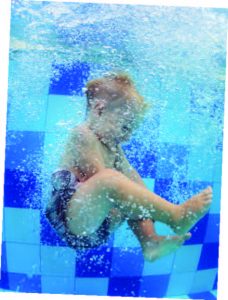
www.istockphoto.com
There are solid numbers to back this up. USA Swimming, the national governing body for the sport, has indicated that participation in formal swimming lessons can reduce the risk of drowning by as much as 88 percent among children aged one to four years. Psychology Today points out that “even more than learning strokes, learning to cope with fear and maintaining ease in the water is what prevents drowning.” For most of us, that begins with childhood swimming instruction. In cases of extreme fear, there are experts ready to step in—Jeff Krieger’s Strategies for Overcoming Aquatic Phobias (S.O.A.P.) and Kimberlee Shults’ program, called Face in Water, to name a couple.
MARCO POLO TO WATER POLO

www.istockphoto.com
Many child psychologists and swimming coaches emphasize that swimming for fun—ranging from playing Marco Polo to competing in serious water polo—is one of the best ways to instill not just a love of water, but also a painless appreciation of cardio activities. Children don’t even realize they are exercising when they’re in the water; they are just enjoying themselves. Swimming is the fourth-most popular cardio activity among Americans (walking and gym-type activities hold the top spots) according to the US Census Bureau. Among youngsters aged 7 to 17, swimming easily moves into the #1 position according to Safe Kids Worldwide.
Editor’s Note: There are any number of ways to begin a summer camp search. The American Camp Association web site (acacamps.org) is a good place to start. If water
We welcome the community to our programs that are designed to educate and inform. Programs are subject to change.
SEMINARS
Seminars, unless otherwise noted, will be held at the CORE Building, 1164 Elizabeth Ave., Elizabeth, NJ
(Enter parking lot from South Broad St., next to Fire House) Light dinner will be served. Call (908) 994-8939 to register.
THURSDAY, FEBRUARY 9
5:30 pm
Go Red for Women Event
Mirette Habib, MD, Interventional Cardiologist
The Westwood, Garwood
Register at https://trinitasrmc-gored.eventbrite.com
THURSDAY, FEBRUARY 22
5:30 pm
Reducing Salt and Enhancing Flavor: How to Fight High Blood Pressure
Michelle Ali, Trinitas Director of Food & Nutrition Services
TRMC Cafeteria
THURSDAY, MARCH 9
5:30 pm
Caring for Your Kidneys
Ruby Codjoe, Nurse Manager, Trinitas Linden Dialysis Center
Register at https://trinitasrmc-kidneys.eventbrite.com
MONDAY, MARCH 20
5:30 pm
Colon Cancer and Preventative Care
Dr. Michael Joseph Viksjo
Register at https://trinitasrmc-coloncancer.eventbrite.com
THURSDAY, MARCH 23
5:30 pm
Each Bite Counts
Michelle Ali, Trinitas Director of Food & Nutrition Services
TRMC Cafeteria
SPECIAL PROGRAMS
SUNDAY, FEBRUARY 26
11:00 am – 5:00 pm
Trinitas Health & Wellness Expo
Make 2017 your healthiest year ever! Presented by Trinitas and the Greater Westfield Area Chamber of Commerce. Featuring exhibits, demonstrations, health screenings, giveaways and speakers. Something for every member of the family.
Snuffy’s Pantagis Renaissance
250 Park Ave., Scotch Plains, NJ
TCCC SUPPORT GROUPS
Conference Room A or Conference Room B
Trinitas Comprehensive Cancer Center
225 Williamson Street, Elizabeth New Jersey 07207
All events take place from 1pm to 3pm.
Call (908) 994-8535 for 2017 schedule.
Living with Cancer
Viviendo con Cáncer, Grupo De Apoyo
Living with Breast Cancer
Viviendo con Cáncer de Mama
Caregiving Support Group
Viviendo con Cáncer, Grupo De Apoyo
Viviendo con Cáncer, Apoyo Familiar
For more information on any TCCC support programs and to RSVP, please contact Roxanne Ruiz-Adams, LSW, (908) 994-8535. Por favor llame al (908) 994-8535 para confirmar su asistencia.
TRINITAS HEALTH FOUNDATION EVENTS
SATURDAY, FEBRUARY 25
5:30 pm – VIP Reception
6:30 pm – Gourmet Dinner
7:15 pm – First Race
13th Annual Evening at the Races
Meadowlands Racing & Entertainment, East Rutherford, NJ
This is an informal event, casual dress and no speeches or formal program! Just amazing food and an evening to spend with members of the Trinitas family! Don’t be left
at the starting gate!
THURSDAY, MAY 4
6:00 pm
Annual Gala Dinner Dance
The Venetian, Garfield, NJ
Join the foundation as they honor Connie Dwyer at this beautiful black tie event complete with fantastic live music, dancing, an incredible auction and amazing food and drink.
For more information about the Foundation or to learn more about its fundraising events, (908) 994-8249 or nbrechner@trinitas.org.
Proceeds from these and other events benefit the patients of Trinitas Regional Medical Center. Making reservations for Foundation events is fast and easy on your American Express, MasterCard, Visa or Discover card!
MEDICAL AND BEHAVIORAL HEALTH SUPPORT GROUPS
Diabetes Management Support Group
Monthly, First Monday, 2:00 – 3:00 pm
Kathleen McCarthy, RN, CDE (Certified Diabetes Educator)
Open to both diabetics and non-diabetics who want to learn more about diabetes prevention.
65 Jefferson Street, 2nd Floor, Elizabeth, New Jersey Call (908) 994-5502 for further information or registration
Sleep Disorders
If you or someone you know experiences problems sleeping, consider contacting the Trinitas Comprehensive Sleep Disorders Center in Elizabeth. Another location can be found in Cranford at Homewood Suites by Hilton with easy access on and off the Garden State Parkway. Both centers are headed by a medical director who is board certified in sleep medicine, internal medicine, pulmonary medicine, and intensive care medicine, and is staffed by seven certified sleep technologists.
For further information, call (908) 994-8694 to learn more about the Trinitas Comprehensive Sleep Disorders Center or visit www.njsleepdisorderscenter.org
Narcotics Anonymous
Monday 7:00 – 8:30 pm
Sunday 12:00 noon – 2:00 pm; Sunday 5:00 – 6:30 pm
Jean Grady, Community Liaison, (908) 994-7438 Grassmann Hall, 655 East Jersey St., Elizabeth
Alcoholics Anonymous
Friday 7:30 pm – 8:45 pm
Jean Grady, Community Liaison, (908) 994-7438 Grassmann Hall, 655 East Jersey St., Elizabeth
HIV Education and Support Program for HIV Positive Patients
Monthly. Call for scheduled dates/times.
Judy Lacinak, (908) 994-7605
Early Intervention Program Clinic, 655 Livingston St. Monastery Building, 2nd Floor, Elizabeth
Mental Illness Support Group (NAMI) for Spanish Speaking Participants
4th Friday of each month except August, 6:30 pm – 8:30 pm Mike Guglielmino, (908) 994-7275
Martha Silva, NAMI 1-888-803-3413
6 South Conference Room, Williamson Street Campus 225 Williamson Street, Elizabeth
TRINITAS CHILDREN’S THERAPY SERVICES
899 Mountain Avenue, Suite 1A, Springfield, NJ • (973) 218-6394
“10 Tips…” Workshops
Come take part in the 7th year of our highly successful Ten Tips Workshop Series. The series is for parents, teachers, or other individuals who work with young children and focus on practical strategies that can be easily implemented into daily classroom and/or home routines. All of our workshops offer suggestions that are appropriate for all children with an emphasis placed on children with special needs and those who may be on the Autism Spectrum.
All workshops take place at the Trinitas Children’s Therapy Services Center, 899 Mountain Ave, Suite 1A, Springfield NJ. Workshops are $15 each.
February 21, 2017 6:00 pm – 7:30 pm
10 Tips for Building Sensory/Tactile Processing
During Circle Time Activities
March 21, 2017 6:00 pm – 7:30 pm
10 Tips for Building Gross Motor Skills
During Circle Time Activities
April 18, 2017 6:00 pm – 7:30 pm
10 Tips for Building Fine Motor Skills
During Circle Time Activities
May 16, 2017 6:00 pm – 7:30 pm
10 Tips for Building Sensory/Tactile Processing
During Large Group Activities Time Activities
June 13, 2017 6:00 pm – 7:30 pm
10 Tips for Building Gross Motor Skills into Large Group Activities
For more information or to register for this last workshops, please contact Christine German, OTD, OTR, at (973) 218-6394, ext. 4012, or email CGerman@trinitas.org
Winter/Spring Programs:
February 20-May 22
All programs are offered one time per week, for 45 minutes at Trinitas Children’s Therapy Services,
899 Mountain Avenue, Suite 1A, Springfield, NJ 07081
These programs and/or group therapy sessions are a great alternative to individual therapy. They give children the opportunity to address key developmental areas in structured but busier environments that are more reflective of typical real-life home and school situations. Classes are grouped by skill and age level.
Scribbles to Script
Children from preschool (prewriting) through elementary school (cursive) have the opportunity to use the Handwrit-ing Without Tears program to learn pre-writing skills, proper letter formation, and writing within the given lines. Multi-sensory fine motor, visual-motor, and visual-percep-tual activities help to reinforce learning and make writing fun! 45-minute classes held once weekly.
Sports 1 Step at a Time
Children between the ages of 4 & 12 will have the opportunity to work with a PT to refine their skill set for several sports, including soccer, basketball, and kickball, in a non-competitive group setting. 45-minute sessions held once weekly. Mondays 4:15 – 5:00
Social Butterflies
Children between the ages of 4 & 12 have the opportunity to become social butterflies by engaging in fun non-challenging therapeutic activities overseen by a speech & language pathologist. Skills taught include turn-taking, topic maintenance, appropriate question asking, following non-verbal cues, and using manners. 45-minute sessions held once weekly. Wednesdays 4:15- 5:00
Typing Whizkids
Children from 1st grade through middle school will participate in functional tasks that will allow them to learn efficient keyboarding/typing skills. From key location and finger placement, to speed and accuracy children will learn this valuable skill the correct way while working with an OT. 45-minute sessions held once weekly. Thursdays 6:15 – 7:00
Cook With Us
An opportunity for children to work with a PT and certified personal trainer, to learn the basics of daily nutrition and fitness, and simple meal and snack preparation, in a practical and fun environment. 45-minute sessions held once weekly. Wednesdays 4:30 – 5:15
Parents Night Out
Please inquire about our quarterly “Parents Night Out” event. Drop your child(ren) off for a few hours of fun play time, a movie and a snack, while mom and dad enjoy a much needed night out. Takes place quarterly.
April 7th 6:00 – 8:30
June 9th 6:00 – 8:30
7th Annual Camp Trinitas
Now accepting registrations for Summer 2017
The program is the perfect opportunity to have children gain new skills or maintain recently-learned motor and academic skills without a full day or even full week commitment.
Sign up for as many days or weeks as you would like.
Sign up for a ½ day or a full day.
We will now be located off-site, with a classroom, an outdoor space, a playground, a kitchen, and a larger gym area! We will now be offering the option of either a ½ day or a full day!
Allow your child to participate in a camp directly organized and supervised by skilled clinicians in their respective fields.
Camp Trinitas is run by OT’s, PT’s, speech therapists, and ABA clinicians, to address each child’s specific needs.
Early Bird Special: 1ST 10 Camp Registrants receive a 10% discount.
Whole Camp Experience Special: Sign up for all 7 weeks and all 28 days and receive an additional 10% discount.
To register for any programs or for more information, please contact Kevin Nelson at knelson@trinitas.org,
(973) 218-6394, ext. 13, or fax (973) 218-6351.
To learn more, visit www.childtherapynj.com
This page is sponsored by
Elizabethtown Healthcare Foundation
Inspired to Care, Inspired to Give
A collection of artifacts and souvenirs tells a forgotten story of summer at the Jersey Shore.
By Rick Geffken
Time has a funny way of erasing the past. Ask your average New Jerseyan to name the state’s most cherished seaside getaway from the past century, and the answer you’re likely to hear is Atlantic City…or possibly one of the resort towns along the Jersey Shore. Pose the same question to their great-grandparents and you might be perplexed by their response: Highland Beach.
Beginning at the end of the 1800s—and going right up through the Great Depression—a sunny summer day might find upwards of 15,000 people crowding onto Sandy Hook, hoping to beat the heat and enjoy the myriad amusements provided by entrepreneur William Sandlass. Sandlass created an utterly unique destination for families who couldn’t afford a fancy summer home or an Atlantic City vacation. Highland Beach developed into a combination day-trip playground and summertime bungalow community, complete with roller coasters, boating and swimming events, souvenir shops, grocery stores, nightclubs and restaurants. Kids made lifelong friends at Highland Beach. Countless romances blossomed there.
All that’s left today of this grand and wondrous place is a single, dilapidated house in the shadow of the new bridge that connects Highlands to The Hook. The building’s peeling exterior obscures what was once the central element of a grand resort—the realized vision of Sandlass, who stood on one of the state’s most desolate pieces of property and dreamed up a middle ground between the chaos of Coney Island and the opulence of Atlantic City. He built it and they came. By the millions. Highland Beach was New Jersey at its very best.
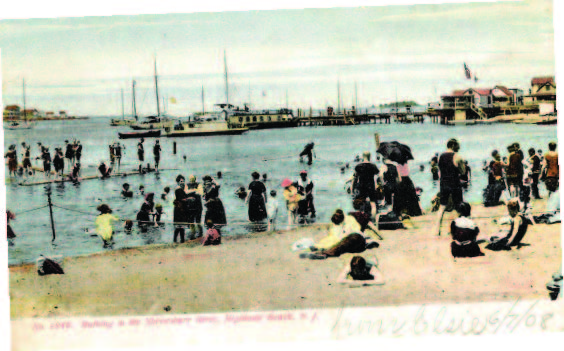
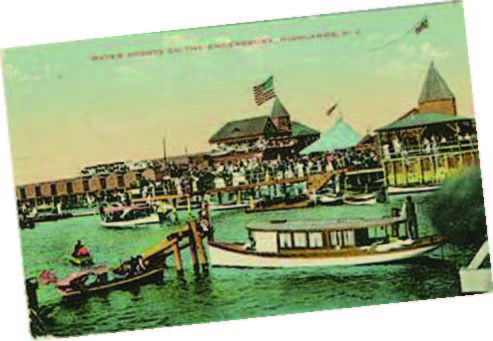
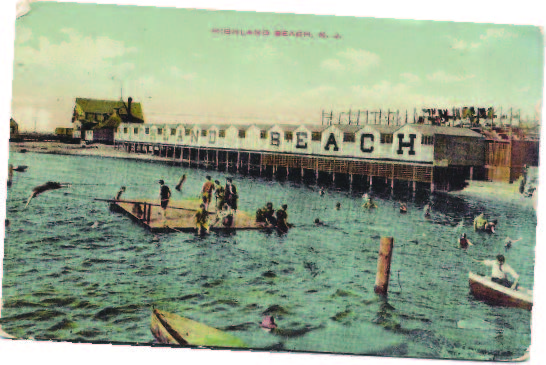


The Highland Beach Pavilion store (circa 1900) provided all the summertime necessities—
including Horton’s ice cream.
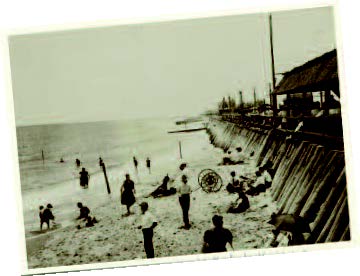
Diners lunch overlooking the ocean side of Highland Beach, while a few courageous souls brave the surf.

A walking bridge connected the Sandy Hook beaches with the upscale hotels in the Navesink Highlands in the 1870s. In 1892, the bridge was rebuilt to accommodate passenger trains taking visitors to Highland Beach.
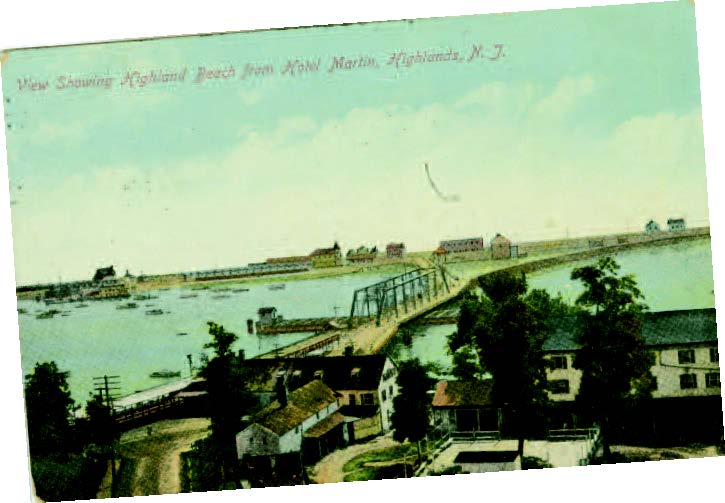

William Sandlass, Jr. and cronies at the Highland Beach Bathing Pavilion, c. 1920s.



The resort as seen from the Atlantic Ocean in 1891, with the iconic Twin Lights lighthouse in the background.
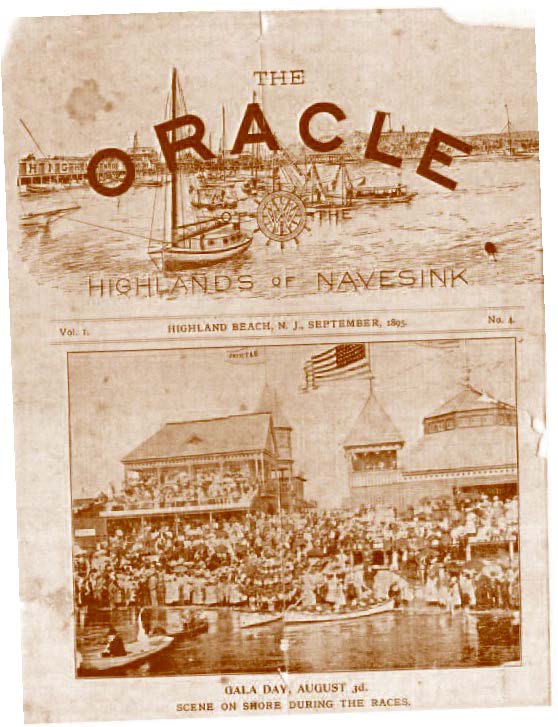

William Sandlass, Jr., pictured here around 1925, cut quite the dapper figure. The son of a German immigrant, Sandlass became something of a country squire due to the success of Highland Beach. He hunted at a Virginia estate he purchased during the last years of his life.
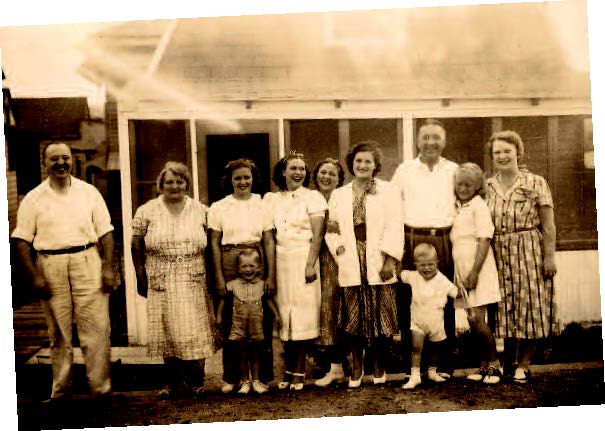
Highland Beach squeaked through the Depression and was still drawing vacationing families in the 1940s and 1950s. “Luau Night” at the Bamboo Room was a chance for summer bungalow residents to mix and mingle with local year-round residents.
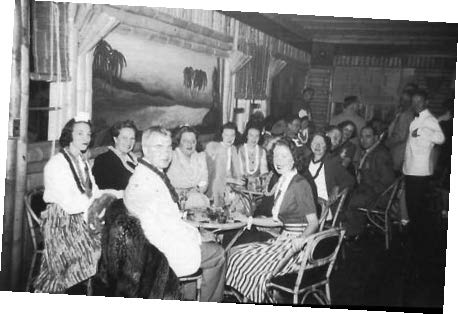
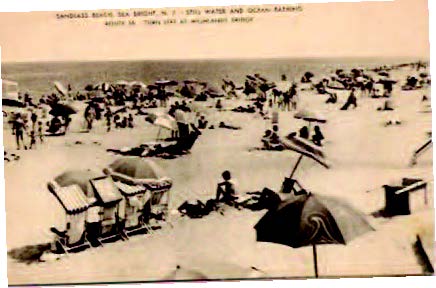
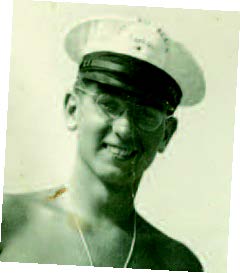
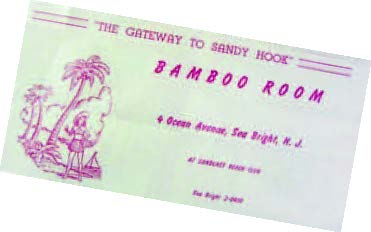
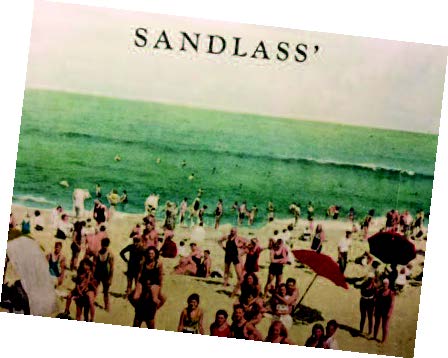
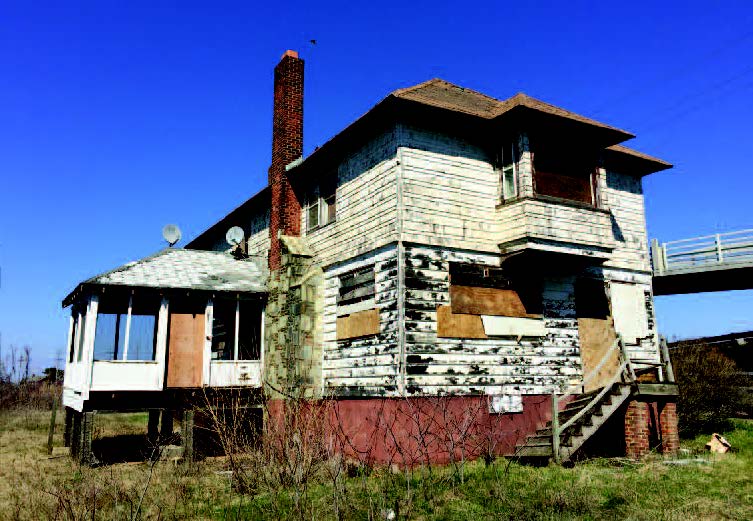
The Sandlass House was occupied until Super Storm Sandy overwhelmed Sandy Hook in 2012. An effort to preserve the only structure from the Highland Beach Excursion Resort as a Jersey Coast Heritage Museum was launched in 2016.

Editor’s Note: A documentary on Highland Beach will be screened at the 2017 Garden State Film Festival. It can be viewed at destinationspast.com. The images for this story were provided by the Sandlass family. The photo at right was taken by the author. For more information on efforts to preserve the Sandlass House, visit the Friends of Highlands Beach, NJ Facebook page.
News, views and insights on maintaining a healthy edge.
Colorectal Cancer Rates: Good News, Bad News
 Seventeen years ago, President Bill Clinton officially set aside March as National Colon Cancer Awareness Month. On the 3rd of the month this year, you’ll see a lot of blue stars around; that Friday is Dress in Blue Day (dressinblueday.org). The good news is that, since 2000, there has been a marked drop in colorectal cancer incidence—more than 30 percent among Americans 50 and older. The distressing news is that,
Seventeen years ago, President Bill Clinton officially set aside March as National Colon Cancer Awareness Month. On the 3rd of the month this year, you’ll see a lot of blue stars around; that Friday is Dress in Blue Day (dressinblueday.org). The good news is that, since 2000, there has been a marked drop in colorectal cancer incidence—more than 30 percent among Americans 50 and older. The distressing news is that,

Samiappan Muthusamy, MD
Past Chief of Gastroenterology/Endoscopy, Trinitas
according to several recent studies, over the next 15 years, the number of colon and rectal cancer cases among adults 20 to 34 is projected to practically double. Cases among adults 35 to 49 are also expected to increase. “The plummeting rates in adults 50 and over were attributable to greater awareness of the importance of screenings and colonoscopies,” says , past Chief of Gastroenterology/Endoscopy at Trinitas. “However, because there are no set guidelines for screenings
of younger Americans, these types of cancers—though relatively unusual between ages 20 and 50—may go undetected. If you have a family history of colon cancer, especially a close family member who was diagnosed before the age of 60, then a colonoscopy is recommended by the time you turn 40.”

The Popsicle Cure
Over the remaining few weeks of winter, there’s a good chance that someone will bring a bug into your home or workplace. If you catch it, one of the symptoms is likely to be a sore throat. In case it’s been a while since you’ve had to deal with this kind of dryness and pain, there are a few important things to remember. According to the National Institutes of Health, keep your throat moist. That means drinking lots of fluids, and having saliva-producing lozenges or hard candies handy. You can even treat yourself to an occasional popsicle. These will help with dryness. Throat sprays and either acetaminophen, ibuprofen or aspirin are good pain-reducers. If soreness persists beyond the normal length of a cold—or if it is accompanied by a fever—see your physician and make sure it’s not strep or tonsillitis.
Networking Error
 Facebook took a lot of heat for propagating “fake news” during the past election, but according to researchers at Lancaster University, there’s something even more depressing: Facebook itself. In a survey of 35,000 people between the ages of 15 and 88, the Lancaster study found that Facebook users who compared themselves negatively with others were at increased risk of depression. Those at greatest risk were individuals who “friended” former partners, made frequent negative status updates or felt intense envy when they observed the “life highlights” of others. The research did point out that social media engagement could also help with depression—when used as a mental health resource or to enhance social support.
Facebook took a lot of heat for propagating “fake news” during the past election, but according to researchers at Lancaster University, there’s something even more depressing: Facebook itself. In a survey of 35,000 people between the ages of 15 and 88, the Lancaster study found that Facebook users who compared themselves negatively with others were at increased risk of depression. Those at greatest risk were individuals who “friended” former partners, made frequent negative status updates or felt intense envy when they observed the “life highlights” of others. The research did point out that social media engagement could also help with depression—when used as a mental health resource or to enhance social support.

Engineering Marvel
When doctors can’t solve a problem, it’s not a bad idea to let the engineers have a crack at it. A case in point is a breakthrough in hemophilia treatment. Researchers at the Cockrell School of Engineering at The University of Texas at Austin have come up with a special capsule that will soon be able to deliver treatment for those who suffer from the hereditary bleeding disorder. The capsule releases micro- and nano-particles that carry a protein therapy that treats hemophilia B. Hemophilia B is caused by a missing or defective factor IX, a clotting protein. Currently, hemophilia treatment is painful and expensive, and is often unavailable in remote regions of the world. As a result, hemophiliacs in developing countries often die in childhood. “Our new oral delivery of factor IX can now overcome these issues and improve the worldwide use of this therapy,” says Sarena Horava, the study’s lead author.
Wait…What?
 More and more women are becoming mothers in their late 30s and 40s than ever before. Although there are certain health risks associated with later pregnancies, researchers at the University of Southern California report that women who have their final baby at age 35 or older appear to have an advantage later in life. The USC study looked at 830 post-menopausal women and noticed that those who had their last baby at age 35 or older had sharper cognitive skills at age 60 than women who stopped bearing children earlier on. Dr. Roksana Karim, who led the study, noted that she would not advise women to wait and have their final child after age 35.
More and more women are becoming mothers in their late 30s and 40s than ever before. Although there are certain health risks associated with later pregnancies, researchers at the University of Southern California report that women who have their final baby at age 35 or older appear to have an advantage later in life. The USC study looked at 830 post-menopausal women and noticed that those who had their last baby at age 35 or older had sharper cognitive skills at age 60 than women who stopped bearing children earlier on. Dr. Roksana Karim, who led the study, noted that she would not advise women to wait and have their final child after age 35.
The study also found that women who had been pregnant twice or more had better cognitive skills later in life than those who had only been pregnant once. More work is needed to explain these links, but researchers suspect they are related to exposure to higher levels of estrogen.
Digging New York
 While medical researchers brave the wilds of the Amazon and other remote regions of the world to look for new medicines, researchers from Rockefeller University have discovered promising microbes a bit closer to home: in the dirt of New York City parks. According to the Proceedings of the National Academy of Sciences, researchers tested 275 samples and found genetic evidence of bacteria capable of producing a wide array of compounds that can be harnessed for new medicines for cancer, as well as for bacterial and fungal infections. “The sheer diversity we saw suggests there are many more potentially valuable compounds out there awaiting discovery,” says Professor Sean Brady, who heads up Rockefeller’s Laboratory of Genetically Encoded Small Molecules. “Even in a place as mundane as urban soil.” One sample from Brooklyn contained genes that encode 25 molecules that are being studied for potential use as antibiotics and other types of medicines.
While medical researchers brave the wilds of the Amazon and other remote regions of the world to look for new medicines, researchers from Rockefeller University have discovered promising microbes a bit closer to home: in the dirt of New York City parks. According to the Proceedings of the National Academy of Sciences, researchers tested 275 samples and found genetic evidence of bacteria capable of producing a wide array of compounds that can be harnessed for new medicines for cancer, as well as for bacterial and fungal infections. “The sheer diversity we saw suggests there are many more potentially valuable compounds out there awaiting discovery,” says Professor Sean Brady, who heads up Rockefeller’s Laboratory of Genetically Encoded Small Molecules. “Even in a place as mundane as urban soil.” One sample from Brooklyn contained genes that encode 25 molecules that are being studied for potential use as antibiotics and other types of medicines.
Walk Before You Run
 So your big New Year’s resolution was to try your first 5K run this spring? Where there’s a will, there’s a way as they say. But you may need to do more than buy a
So your big New Year’s resolution was to try your first 5K run this spring? Where there’s a will, there’s a way as they say. But you may need to do more than buy a

Jim Dunleavy, PT DPT MS Director, Rehabilitation Services 908.994.5406
new pair of running shoes. According to the American Council on Exercise, you’ll need to give yourself at least
five weeks to prepare. At the start, it’s important to walk and run about 25 minutes four days a week—and then gradually increase the distance and duration, as well as varying the workout. Also, have a high-carb snack before you workout, and drink lots of water.
Before entering your first 5K, or when starting any exercise program check with your medical doctor first—especially if you have any chronic conditions such as a cardiac, lung or blood condition, says Dr. Jim Dunleavy PT DPT MS, physical therapist and Director of Rehabilitation Services at Trinitas. “Also, remember to set reasonable distance and time goals and slowly build up to your ultimate goal in order to avoid joint, muscle and tendon issues.” Finally, check out the course so there are no surprises on race day.
A LADY IN RED
Trinitas Health Foundation held its Red Dress raffle drawing for an elegant full-length gown from the Aidan Mattox Occasion Shop at Bloomingdale’s in Short Hills. Terry Finamore, Stroke Program Coordinator, drew the winning ticket and Barbara Baglin of the Trinitas Pharmacy Department was the lucky winner. Nadine Brechner, Vice President of the Trinitas Health Foundation, reports that $1,360 was raised from the raffle. This donation will support the cardiac area in the new Emergency Department. A big thank you to Bloomingdale’s and Aidan Mattox of Short Hills Mall for this glamorous donation!
MONEY WELL SPENT
Union County Savings Bank made a special donation of $100,000 to the expansion of the Trinitas Emergency Department. No stranger to giving, Union County Savings is one of the leading companies in Union County that continues to give support and uplift the community through its charitable efforts. From left to right; Nadine Brechner, VP of the Trinitas Health Foundation, poses with Dr. John Donahue, retired Trinitas surgeon and Trustee of the Union County Savings Bank Board, Mr. Don Sims, President and CEO of Union County Savings Bank, and Gary S. Horan, President & CEO of Trinitas RMC.
 TOUCHDOWN FOR TRINITAS!
TOUCHDOWN FOR TRINITAS!
Trinitas Health Foundation’s 3rd Annual Tailgate with Trinitas event was held on Sunday, December 4th. The event featured five past prominent players, Harry Carson, Stephen Baker, Charles Way, Bart Oates, and Bill Neill, each of whom were on-hand to revel in the festivities. With endless amounts of “tailgate” food, as well as beer and wine, the event has become part of the Trinitas Health Foundation’s fabric. We hope you can join in on the action next year! Pictured from left to right President & CEO of Trinitas, Gary Horan, Hall of Famer Harry Carson, Bill Neill, Irv Brechner, Charles Way, VP of Trinitas Human Resources, Glenn Nacion, and Stephen Baker.
SAVE THE DATE! Trinitas Gala honoring Connie Dwyer on May 4th at the Venetian! Call Nadine at 908-994-8249 for more details!
Vision becomes reality with a groundbreaking behavioral health partnership.
By Mark Stewart
 The future of healthcare is a topic of considerable debate in this country. Experts will argue endlessly the pros, cons and particulars of the various industry sectors, and consumer advocates will probably be battling with insurance companies until the end of time. Interestingly, there is one thing everyone seems to agree on: Integration of services is the key to any real progress. It was against this backdrop that Trinitas
The future of healthcare is a topic of considerable debate in this country. Experts will argue endlessly the pros, cons and particulars of the various industry sectors, and consumer advocates will probably be battling with insurance companies until the end of time. Interestingly, there is one thing everyone seems to agree on: Integration of services is the key to any real progress. It was against this backdrop that Trinitas  Regional Medical Center and St. Joseph’s Regional Medical Center in Paterson forged an Integrated Behavioral Health Network—one of the largest and most comprehensive in the region. The partnership was announced in late 2016.
Regional Medical Center and St. Joseph’s Regional Medical Center in Paterson forged an Integrated Behavioral Health Network—one of the largest and most comprehensive in the region. The partnership was announced in late 2016.
Both hospitals offer behavioral health programs, services and treatment centers on their main campuses and satellite facilities in their respective counties (Union and Passaic). Both have points of access in Essex County, as well. With the Trinitas-St. Joseph’s Behavioral Health Network, patients in all three counties can get the specialized care they need throughout the entire Trinitas–St. Joseph’s system.

Maria V. Padron, MD, Medical Director, Child Adolescent Outpatient Unit at Trinitas Regional Medical Center.
The goal of the initiative is to promote behavioral health by making the process seamless and less stigmatizing for the patient, says Dr. James McCreath, the Network’s Executive Director.
“We’re looking for ways to bring behavioral health to the primary care office,” Dr. McCreath explains. “For example, if your doctor is treating you for a heart condition and notices signs of depression, we want it to be easier for you to arrange that evaluation or consult right then and there—without having to make a lot of frustrating phone calls or hunting for information on web sites. This integration of services recognizes how mental health impacts other health issues, and vice versa.”
The genesis of the Network was a discussion between Gary Horan, President and CEO of Trinitas, and Kevin Slavin, his counterpart at St. Joseph’s, about how their hospitals could provide integrated services. The obvious first step was to have one Chair of Psychiatry oversee both sites. Trinitas had a chairperson retiring, while St. Joseph’s was in the process of hiring one. The individual they chose to manage the entire system was Dr. Carlos Rueda. It made sense to integrate on the administrative side as well, so the two hospitals agreed to share the management expenses.

Dr. Carlos Rueda Regional Chairman of Psychiatry/Behavioral Health
Trinitas-St. Joseph’s Behavioral Health
Network
“One of the great challenges facing patients with mental health needs is getting into the right program that offers the greatest benefit,” says Dr. Rueda. “Our vision for the integration at a system level was to be able to offer uniform services over larger geographical areas. So, for instance, patients with an emergency visit in Elizabeth who want to follow up with a Paterson doctor can be managed with a simple release. That convenience factor of having a system large enough to provide all the services a person might need has myriad benefits.”
This is especially true in cases where one hospital has a particular strength or specialized service. For instance, St. Joseph’s offers psychiatric services for the hearing impaired. If a hearing-impaired patient of a Trinitas physician needs mental health services, that office can make an immediate referral, rather than just handing them a phone number. Likewise, if St. Joseph’s doctors see elderly patients dealing with anxiety issues, they can set up appointments with the Trinitas program that sends staff out to the homes of the elderly. The Network is likely to have a major impact on children and adolescents in need of psychiatric care who come to St. Joseph’s. Before, their doctors had to call around to locate a bed. Now there is a protocol to have those patients admitted to Trinitas, which excels in this area.
There are significant benefits to the two hospitals, of course. In addition to creating a system that promotes better patient outcomes, Trinitas and St. Joseph’s put themselves in a stronger position to negotiate and be a more active partner with insurance companies.

Dr. James McCreath Executive Director
Trinitas-St. Joseph’s Behavioral Health
Network
“From the consumer side, dealing with the healthcare system can be very complex at a stressful time,” Dr. McCreath says. “Getting authorizations and approvals is difficult. But having a system large enough so that you can go through us to identify resources—rather than dealing with the insurance companies—relieves a lot of that stress.”
“It’s not just about being bigger,” adds Dr. Rueda. “It’s about offering greater access to people who may not have known where or how to get these critical services.”
THE NETWORK
 The Trinitas-St. Joseph’s Behavioral Health Network brings together more than 700 employees and staff members with an annual budget of $50 million. Patients will have access to more than 40 psychiatrists. The Network will provide more than 350,000 outpatient contacts in 2017 and over 3,000 inpatient admissions.
The Trinitas-St. Joseph’s Behavioral Health Network brings together more than 700 employees and staff members with an annual budget of $50 million. Patients will have access to more than 40 psychiatrists. The Network will provide more than 350,000 outpatient contacts in 2017 and over 3,000 inpatient admissions.
 DID YOU KNOW?
DID YOU KNOW?
In 1933, Elizabeth General (the precursor to Trinitas) created the first inpatient psychiatric program east of the Mississippi. In 1972, the hospital opened the first community mental health center in the state.
What you don’t know can hurt you.
By Alison Hemstitch
Over the next couple of months, Spring Break stories will be taking up a lot of bandwidth. College students and 20-something singles will be invading beach towns around the country for a week of drinking and debauchery. Lost in the blur of bikini parties is the fact that a huge number of young families also fly south to catch a week of sunshine before the first whispers of spring.
Unfortunately, a certain percentage of vacationing families will be victims of illness, accidents and other mishaps. The better prepared you are and the clearer you are in terms of your actions and options, the less likely they are to be vacation-killers.
“Spring vacation is a great time for families,” says Yelena Samofalov, MD, of the Trinitas Pediatric Health Center.“
Making it safe is just as important as making it memorable. Before you travel, find time to visit your family doctor to make sure you and your kids receive any necessary vaccines. For instance, flu season might be over here in New Jersey, but in other parts of the world it could still be a factor.”
Most warm-weather vacation problems start at—where else?—the water’s edge. The obvious ones involve the sun. Keep in mind that your kids have probably been dealing with a New Jersey winter for several months and that they will burn quickly and easily. A lot of families will check in to their hotel, tear off their travel clothes and sprint toward the water, making up for lost time, as it were. An hour frolicking on the sand or at a resort pool is all you need to get a bad burn.

BURNING LOVE
Needless to say, any time spent under an open sky demands sunscreen with a minimum 30 SPF. Most adults can go 20 minutes before having to cover up. However, on a hot, sunny day a child with sensitive skin can start burning in less than 10 minutes without protection. If kids sweat or go swimming, you’ll have to reapply. So either travel with a plentiful supply of sunscreen or make sure you can buy it easily where you’re staying. If you rent a car, it’s a good idea to take an extra container and throw it in the glove compartment. Okay, so now your child is beet-red and in excruciating pain. First of all, know when it’s time to seek medical attention. As a rule, a temperature of 101 or more is the tipping point. And a severely burned baby (one year or younger) should generate a call to the doctor, because sunburns are extremely dehydrating. By definition, this is an emergency.
For older children, hotel-room treatments and remedies are fairly straightforward. The first move is a cool (not cold) shower or bath. No soap. No rubbing dry. Next, a visit to the ice machine. Wrap a handful of cubes in a damp hand towel and apply it to the reddest areas. If pure aloe vera gel is in your survival kit, apply it liberally and often—it speeds healing and moisturizes. You can also soak a washcloth in milk and use it as a compress. Milk will create a kind of protein film that will reduce the heat. Also, monitor how often your patient is urinating. You’ll want to give them water and juice to keep them hydrated for then next few days.
DON’T EAT THAT!
Another source of vacation misery is food poisoning. Many families will try to save time or money by packing sandwiches for the beach and tossing them in a cooler. Be aware that anything involving meat, cheese, mayo and other condiments may spoil quickly and cause problems later. Better to plan a day at the beach between meals and bring dried fruit or cookies to keep up the energy of the little ones.
Of course, most of your vacation meals will be prepared by someone else. So there is no telling how diligent they are about food safety. And then there is the resort buffet, where your fellow guests have an opportunity to contribute their germs to the mix.
Should your child develop nausea, a stomach ache, diarrhea or start vomiting, don’t panic. Food poisoning is ugly but it is not a total vacation-killer. In many cases, with enough rest, the kid will bounce back in two or three days. The key is to avoid dehydration—this happens in a child much faster than in an adult. Make sure they consume (and keep down) five ounces of clear liquid per hour. And station them close to the bathroom. If abdominal cramping is severe, a heating pad on the stomach will provide much-needed relief.
Once the nausea and diarrhea have stopped, reintroduce food gradually. Bananas are ideal in a vacation setting. A room service order might include toast, noodles or rice and eggs. One mistake parents make is to give milk to a recovering child. The enzymes in their small intestine have been wiped out and they may not be able to process the lactose.
The good news is that what appears to be food poisoning might not be food poisoning at all. Sometimes, on vacation a child will try some unfamiliar food and discover he or she has some kind of intolerance. Also, babies and toddlers have been known to eat sand. Yeah, that happens. In both cases, evacuation is usually fast and furious and your vacation won’t miss more than a half-beat.
SKIN DEEP
Less likely to ruin a vacation but more common are the scratches, scrapes and cuts a child will suffer in an unfamiliar environment. The same is true of insect bites and stings. Skin cuts and abrasions get the same treatment on vacation as at home. Wash them thoroughly with soap
under running water for several minutes, and make sure to gently scrub away dirt with a washcloth. Cover the wound with a bandage and some Polysporin, and change the dressing once or twice a day, or more often if it gets wet. Better yet—especially if you’re on vacation near a body of water—use a liquid bandage product. You may get through the entire vacation with a single application.
With bug stings and bites, it is very important to monitor your child’s reaction. If you already know your child is allergic to, say, bee stings, then you are familiar with the immediate action steps—an Epinephrine injector is a must. If not, then facial swelling, a severe rash, dizziness, labored breathing—or any combination—are signals to locate a doctor ASAP. Remember, in a vacation setting you may encounter an entirely new creature. In Mexico, for instance, baby scorpions are known to hide in all sorts of odd places.
Pain, itchiness and swelling are typical results of insect encounters. Without an allergic reaction, though, they are rarely causes for panic. If an area becomes infected, however, that can turn serious. It is important to treat stings and bites quickly and intelligently. Wash the site with soap and water, apply ice on and off 5 to 10 minutes at a time, and feel free to use children’s ibuprofen or acetaminophen. Calamine lotion can also keep the site from itching. In a pinch, a baking soda paste will work just as well. An antihistamine cream is a good option, though not for infants and toddlers.
BRING IT
So how best to fill one’s survival kit? Responsible parents will bring knowledge, experience and an arsenal of emergency remedies. According to Dr. Samofalov, don’t leave home without the following:
- Thermometer to check for fevers
- Sunscreen SPF 30 (x2)
- Children’s Tylenol or Advil to control fever or pain
- Instant cold pack for minor injuries
- Antihistamine spray for insect bites
- Adhesive bandages for cuts and scrapes, including a large patch-size
- Polysporin to prevent cuts from getting infected
- Calamine Lotion or A and D ointment
- Aloe Vera Lotion
- Insect repellant spray or wipes (use on clothing to avoid skin irritation)
- Heating Pad
- Liquid bandage
You’d think these Spring Vacation survival essentials would be available at your destination, day or night. You’d be wrong, cautions Dr. Samofalov.
“Getting sick on vacation is never part of the plan,” she adds, “but if it happens, don’t be shy about visiting a doctor or emergency room. Remember, it’s better to be safe than sorry.” EDGE
PLANE SPEAKING
 For some families, a spring vacation can “go South“ at the end of the jet way. Follow these three rules and at least you’ll get to your destination unscathed.
For some families, a spring vacation can “go South“ at the end of the jet way. Follow these three rules and at least you’ll get to your destination unscathed.
- Put kids at the window or in the middle seats. Aisle seats can be hazardous to little fingers and toes—and heads. Adults stumbling to the rest room or fumbling with the overheads are accidents waiting to happen. And then there are those drink carts. Imagine spending a week at Disney World nursing your kid’s crush injury.
- Keep kids belted. Sudden turbulence can send a small body flying. You may have a vague recollection from high school physics class about how this works. Just as important, belted children are less likely to annoy the passengers directly in front of them.
Think big. Most/many airlines still allow a “lap child” under the age of two at no charge. If you can afford the extra seat, buy it. Bookending your vacation with a screaming, squirming infant is the definition of sheer misery. Same goes for a toddler. This is the beauty of car seats. Check to see if yours hooks into airline buckles.
GO-TO SPOTS
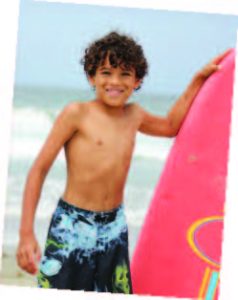 According to Travel Channel, these warm-weather destinations are among the hottest family vacation targets for Spring ’17:
According to Travel Channel, these warm-weather destinations are among the hottest family vacation targets for Spring ’17:
Club Med • Dominican Republic
South Seas Island Resort •
Florida
Kauai Surf School • Hawaii
Loews Coronado Bay • San Diego
Sandy Lane • Barbados
Paradise Island Resort • Bahamas
 Yelena Samofalov, MD Trinitas Pediatric Health Center 908.994.5750
Yelena Samofalov, MD Trinitas Pediatric Health Center 908.994.5750
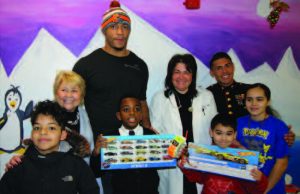
TOYS FOR TOTS MAKES A SPECIAL DELIVERY
Toys for Tots paid a visit to the Trinitas Pediatric Health Center and brought along two surprise guests. NFL Player Desmond Bryant (center) and Marine Ramon Perez (far right) made a special delivery for all the children visiting the health center on December 15th. The gifts were donated to the center as part of Toys for Tots’ continuous effort to make the holidays special for every child. Nadine Brechner, VP of the Foundation (far left) and Dr. Samofalov made sure the gifts were distributed to some of the center’s proudest patients.

POPP CULTURE
Summit Mayor Nora Radest joined salon owner Vicki Jimenez and her team of stylists to celebrate the opening of the new Vicki Popp Salon in Summit. Jimenez is passionate about great hair care and is committed to offering area residents a personalized beauty experience in her new state-of-the-art salon. “Our goal is to ensure that our clients’ hair doesn’t just look good the day they leave the salon,” says Jimenez, “but that they will be able to style it easily themselves and look amazing every day.” The salon is located at 456 Springfield Avenue.

KEEPING TRADITION ALIVE
The George Miller Art Society kicked off the holidays by donating its artistic services to the Trinitas Child and Adolescent wing of New Point Campus. George Miller, a North Arlington based high school teacher, touched the lives of many students in his 30-year career before his passing in 1993. Co-founders and former students Andrea Jennings (left) and Daniel Marck (right) strive to continue this tradition to spread cheer and promote artistic expression in Miller’s memory. Special thanks to the family and friends of George Miller for their help in keeping one of Mr. Miller’s finest philanthropic traditions alive.
 ROOM TO GROW
ROOM TO GROW
Chatham Day School recently completed a $6 million expansion project, which includes a new wing for Upper and Middle Schoolers. Students have a new theater, dining hall and S.T.E.A.M. Suite.

TRINITAS EMS RAISES THE BAR FOR SAVING LIVES
The American Heart and Stroke Association honored Trinitas Regional Medical Center Mobile ICU with the 2016 Mission: Lifeline EMS Recognition Gold Award for decreasing the “door-to-needle” timeframe for cardiac patients. The success of the Trinitas Mobile ICU program is due in great part to the joint effort between the Trinitas EMS squad and the local Elizabeth Fire Department.

DEDICATED TO EXPANSION
From Left to Right: Kathleen Shevlin, Nadine Brechner (Trinitas Health Foundation) and Gary Horan (President & CEO of Trinitas), pose with Beth Levithan, PhD and Marsha Atkind, from the Healthcare Foundation of New Jersey, and Dr. John D’Angelo as they dedicated three key areas of the new Emergency Department at Trinitas Regional Medical Center. The Foundation granted$500,000 for the geriatric unit, $250,000 for the diagnostic suite, and$1 million for the transitional care unit.

HOSPITALS JOIN FORCES TO FIGHT DRUG OVERDOSES
Trinitas Regional Medical Center in Elizabeth, Overlook Medical Center in Summit, and Robert Wood Johnson University Hospital in Rahway, all recently signed memorandums of understanding with the Union County Prosecutor’s Office to provide the counter-active drug — commonly known as Narcan — to all police departments in the county at no charge to the police. This drug is used to counteract opioid overdoses, and saved 124 lives in the first 10 months of use by police officials throughout Union County.
Movement. Energy. Color. To the trained eye, New Jersey offers an endless bounty of subject matter. Throughout 2017, EDGE will celebrate artistic excellence in its new Local Talent section. We begin the year with the work of Thomas Wacaster, an illustrator by trade whose body of work includes oils and pastels. A graduate of Newark’s School of Fine and Industrial Arts, Tom studied under legendary illustrator Irv Doktor in Greenwich Village. His paintings have been displayed at numerous exhibits and galleries in New Jersey. More than 40 of his paintings, commissioned by the Ford Foundation, have graced the walls of the McGraw-Hill building in New York City.

Erie Lackawanna, Oil on Canvase, 36″x24″

In an impromptu ceremony atop the parking garage, Tom presents a painting of the Trinitas campus to Medical Center CEO Gary S. horan, FACHE.

5:10 to Elizabeth, Oil on Canvas, 12″x9″

Hunterdon Balloons, Oil on Canvas, 20″x10″

Late Summer in Menlo Park, Oil on Canvas, 24″x18″

Uncle Bob, Oil on Canvas, 16″x20″

Parkway Cosmos, Oil on Canvas, 16″x12″

Jersey Breakers, Seaside, Oil on Canvas, 24″x18″

Editor’s Note: Tom Wacaster is a resident of Clark. His work took first place in the 2016 Union County Senior Citizens Art Exhibit and second place in the state-wide seniors competition.
How to get your dream pool…without getting in over your head.
By Caleb MacLean
March is swimming pool season. As winter recedes, our thoughts turn to summer fun. This is when New Jersey pool-builders get busy, pressured to complete their projects by Memorial Day. Or sooner. If you’re just now getting ready to pull the trigger on a pool project, might I make a suggestion: Rather than rushing into things, consider taking the summer to educate yourself. Ask friends and co-workers what they would change about their pool, and what they wouldn’t. Find out what they might do differently if they could have a do-over.
In the world of backyard swimming pools, you don’t want to learn from your mistakes. Better to learn from someone else’s.

FIRST THINGS FIRST
Before meeting with a salesperson or a construction outfit, there are some basic decisions to be made. First and foremost, a family must be clear on how a pool will be used, and by whom. Is it primarily for kids to splash around in? Is it for exercise or, down the road, might it need to fulfill a hydrotherapy function? Do you envision the pool area as an entertainment space? Is it part of an overall landscaping makeover? The more succinct your vision is, the better your chances of getting the pool you want/need instead of the pool someone is trying to sell you.
Many people find it helpful to think about the poolside experiences they’ve had at the homes of family, friends and neighbors. What worked and what didn’t? What things might work for you and what might not? Rank those pools in your head and do a deep dive into pool number one: How close is it to the one you envision in your own back yard? Remember not to develop “pool envy.” That’s a real thing. Just because you had a blast at someone else’s house, doesn’t mean that their excellent water slide and multimedia tiki bar are a good fit for your circumstances. Or budget.

THE B WORD
Ah, yes. Budget. Once you have a sense of what you want in a pool, you can then ask yourself the big question: How much can we afford to devote to the project? This number must take into account every expense, down to furniture and accessories, as well as seasonal upkeep and general maintenance.
For most people at this point a reality check is required. Because your pool budget has to cover the actual cost of the finished project, you’ll need to know what the finished cost will be. There are two numbers to calculate: the cost of a fully realized recreational and entertainment “oasis” and the cost of a nice backyard pool.
Why price out both? Because you are likely to end up somewhere in between. No one gets absolutely everything they want in life; the same is true of pools.
The good news is that, to a certain extent, a major pool project can be accomplished in stages. If your ultimate aim is to surround your pool with a gourmet kitchen, sports bar, deluxe pool house and cutting-edge outdoor AV array, it will be more cost-effective to run the utilities out to the site while the ground is open than to do so after the fact. You can add those neat things down the line. Needless to say, the high and low numbers you end up with will have a significant spread. While a basic pool installation may run you $25,000 (that figure comes courtesy of Angie’s List), your future wish-list pool could come in at 10 times that number, or more.
So what is a really nice pool going to cost you? The principal contributing factors are likely to be its size and shape, systems, materials and finishes, and those must-have extras.
POOL SIZE
Ha-ha. Yes, it does matter. If anyone in your family is intent on swimming laps, you’ll want something in the 35- to 40-foot range. Otherwise, a 24-foot pool should be adequate for a typical family. Most pool builders like dealing with rectangular configurations in “off-the-rack” dimensions of 10’ x 20’ or 15’ x 30’ or 20’ x 40’ with an average depth between five and six feet, and a deep end around eight feet. A good builder can execute any size, shape and depth, of course. A big pool is tempting, but a small pool has two major advantages: It costs less to maintain and leaves more room at poolside (and also in your yard) to do other things.
MATERIALS
For in-ground pools, there are three basic choices when it comes to liners: concrete, fiberglass or vinyl. A concrete (aka Gunite) pool can be any size or shape or depth you can imagine. If you can draw it on a piece of paper, a builder can make it happen. It takes longer to install than vinyl or fiberglass and will probably have to be totally renovated in 15 years or so. Concrete pools also require more chemicals to maintain and should be cleaned more often, so your pool service bill will be higher.
Pools using vinyl liners cost less to construct and are good for kids because there are no abrasive surfaces. Vinyl is also less likely to harbor algae growth. The downside of vinyl is water loss. A small puncture can drive you crazy and cost a lot to repair. Also, liners rarely last more than 10 years before you need to think about replacing them. However, the replacement cost is about a third of redoing a concrete pool.
 Fiberglass pools are pre-fabricated (kind of like giant bath tubs), trucked to your site and can be fully installed within three weeks. Their initial cost is about the same as concrete. In terms of having to be resurfaced, that’s not something you’ll ever have to worry about—you’ll be long dead before the liner wears out. There is a savings on chemicals, and also on accessories such as steps and ladders, because they are incorporated into the design. The issues that many people have with fiberglass pools include the meager selection of sizes and shapes, and the fact that they cannot be more than 16 feet wide, because of trucking limitations.
Fiberglass pools are pre-fabricated (kind of like giant bath tubs), trucked to your site and can be fully installed within three weeks. Their initial cost is about the same as concrete. In terms of having to be resurfaced, that’s not something you’ll ever have to worry about—you’ll be long dead before the liner wears out. There is a savings on chemicals, and also on accessories such as steps and ladders, because they are incorporated into the design. The issues that many people have with fiberglass pools include the meager selection of sizes and shapes, and the fact that they cannot be more than 16 feet wide, because of trucking limitations.
The construction cost of an average concrete pool is slightly north of $100 a square foot. It’s about the same for fiberglass. So for a nice 15’ x 30’ pool, you’re looking at$40,000 to $50,000. That includes a high-quality pump and heater, nice-looking tiles and other finishes, some basic lighting, a few feet of perimeter surfacing, safety fencing and a motorized cover. The same size pool with a vinyl liner might run 20% less.
BUT WAIT…THERE’S MORE!
A kidney-shaped pool that fits the same footprint runs a bit higher. More customized shapes will nudge the per-foot cost ever upward. If you’re planning something really unique, it might be wise to consult with an engineer—likewise if your pool or decking requires a retaining wall. Incidentally, here’s a good rule of thumb in that regard: If a pool builder says you “might” need a retaining wall or if you yourself think you might need one…you will need a retaining wall. Also, unless you’ve got a strong back and a green thumb, you’ll easily get into four figures on landscaping and plantings. And you’ll probably want some cool lighting to highlight the landscaping, in addition to lights for nighttime safety.
Another cost that catches prospective pool owners by surprise is the surface around the pool. Most quotes include three or four feet of concrete and that’s it. If you need more than that, or if you desire special materials or finishes, such as slate or fancy tiles, you’ll be paying through the nose (and by the square foot). Other “hidden” costs in pool construction include removal of the dirt, as well as driveway repairs. Demand that dirt and debris removal be included in the price quoted and in the contract. In terms of your driveway, the heavy equipment required to dig a pool will almost certainly mess it up. That cost is on you
Finally, there is the question of including a spa or jacuzzi or hot tub in your pool plans. Building one after the fact can run $8,000 to $10,000. If you fold it into your original design, it can share the same plumbing and heating, which translates to a huge savings. Still, expect to add an additional $5,000 for a first-rate spa.
DEEP DIVE
Anyone with a pool will tell you that one of the first questions posed to them when negotiating a new homeowners insurance policy is Do you have a diving board? That is because diving boards are inherently dangerous. A pool with a diving board needs to be significantly wider than a pool without; many towns actually have ordinances that dictate minimum sizes now. The reason should be obvious: Anytime you or a guest goes airborne, swimmers within 10 feet are potential insurance claims. Children do stupid things on diving boards, yes, but it’s the grown-up reliving a childhood moment who is the real idiot. At three or four times the body mass of a child, an adult becomes a deadly projectile—especially if there’s a kid on the receiving end of a flip or belly-flop. Depending on your carrier and policy, expect a diving board to increase the liability portion of your insurance by at least 50 percent
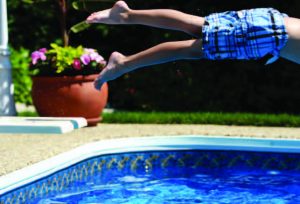 If, after weighing the pros and cons of a diving board, you decide it’s right for you, then there are two basic types to consider. Jump boards offer varying degrees of flexibility and spring action, while dive boards are fixed and relatively stiff. Some people get them mixed up because their names kind of describe each other. Jump boards are what we used to call “springboards”—the ones that literally had visible springs coiled at the base. Today’s jump board assemblies look more like the curved leaf springs you see under a truck.
If, after weighing the pros and cons of a diving board, you decide it’s right for you, then there are two basic types to consider. Jump boards offer varying degrees of flexibility and spring action, while dive boards are fixed and relatively stiff. Some people get them mixed up because their names kind of describe each other. Jump boards are what we used to call “springboards”—the ones that literally had visible springs coiled at the base. Today’s jump board assemblies look more like the curved leaf springs you see under a truck.
Other details you should be aware of before purchasing a board include durability, weather sensitivity and weight capacity. If you know 350-pound Uncle Willie or Aunt Wilma will be demonstrating their famous jack-knife dive, make sure the board you buy can accommodate them. There are also industry standards about the ratio between the length and height of a diving board and the depth of the pool. As a rule of thumb, figure at least an eight-foot depth below the point of entry for a typical dive.
THREE MORE THINGS TO THINK ABOUT
As with any addition to your property, there is a question of aesthetics involved. Everyone wants a nice-looking pool, but do you want it to be an extension of your home’s architecture or existing outdoor elements? If you live in a funky old Victorian house, you may have trouble finding someone to build a funky old Victorian pool. However, it’s not impossible. Every architectural style has a pool design to match, or at least to complement it. On the other hand, you may want your pool area to offer a completely different environment from your home—especially if you own a large property. In this case, consider the creation of a transitional area between the house and pool. That will add some design and landscaping costs to your budget, but it will be worth the extra expense.
Most towns in New Jersey have a specific set of ordinances covering pool installation and operation. Make sure you know what they are, because there is no guarantee your pool builder will. In some cases, zoning and building laws may determine the size and location of your pool. For instance, where rainwater drainage is a concern, many municipalities want to know what percentage of your yard will no longer be grass, and how a new pool might change runoff patterns. Also, some towns require notification of neighbors prior to construction, so there may be some surprises there. Another surprise may be a bump in your property tax assessment.
What if you want that dream pool now but haven’t tucked away nearly enough cash to complete it? There is always the financing option. Many pool builders can arrange this for you through a third-party lender. These loans are typically short-term (three years or less) at a reasonable interest rate (usually in the neighborhood of 5%). If your credit and income check out, pool loans can be unsecured so as not to tie up equity in your home, as a traditional second mortgage or home equity line of credit might. Some people do take loans out against their homes to finance a pool project (as there may be some tax advantages).
One last word…be aware that a swimming pool is not an investment. You can’t count on recouping this cost. It is purely for your family’s enjoyment. Keep that in mind and you will get the pool you want and keep your head above water.
WHAT LIES BENEATH
 Not every property is suitable for every type of pool. Some of the conditions that can add significantly to the expense of an in-ground pool are loose, sandy soil or soil that contains numerous large rocks and boulders. Also, depending on where you live, it may be worth checking how the land was used before a house was constructed on it. Someone is living on top of the 1890 town dump, right? Is it you? A surprise like that could add $10,000 or more (a lot more, actually) to the price tag of pool construction. Professional soil testing is a smart first step.
Not every property is suitable for every type of pool. Some of the conditions that can add significantly to the expense of an in-ground pool are loose, sandy soil or soil that contains numerous large rocks and boulders. Also, depending on where you live, it may be worth checking how the land was used before a house was constructed on it. Someone is living on top of the 1890 town dump, right? Is it you? A surprise like that could add $10,000 or more (a lot more, actually) to the price tag of pool construction. Professional soil testing is a smart first step.
Editor’s Note: Caleb MacLean “inherited” a previous owner’s swimming pool when he bought his current home. It was not kid friendly (nor adult friendly, for that matter) and when it came time to re-line it, he chose to make it into the biggest goldfish pond in the county instead.
“Roasted lamb belly was the first-round standout, a yin-yang of tenderness of texture and strength of seasoning.”
By Andy Clurfeld
INC
302 George St., at the corner of New Street, New Brunswick
Phone: (732) 640.0553
Reservations and major credit cards accepted. Hours: Open Monday through Friday from 4 p.m. till 2 a.m. and Saturday from 5 p.m. till 2 a.m. Closed Sundays.
Prices: Bites: $8.50 to $24.50. Vegetable-based starters: $8 to $13. Entrees: $17 to $26. Extras: $4 to $7, Burgers: $12 to $15. Desserts: $6 to $8.
Our server needs to be flagged down because I forgot to order the House Made Spicy Pickles INC has become justifiably famous for its bill of whiskey fare and cleverly monikered cocktails notwithstanding
How could I do this? I’d prioritized the items on the menu days ahead of time. The pickles were the first item I’d checked off on the list that needed to be winnowed down or risk overloading the kitchen (Server to Intake Chef: “Table 17 wants to run the table—er, menu.” Intake Chef: “Are you waiting on the Olympic Sumo Wrestling Team?”) or merely alarming the back-of-the-house crew. Who could not want these pickles, served in a crammed-full Ball-style jar with jalapeno, garlic, dill, a dash or five of Tabasco, and aromatic from 20 paces?
“Andy,” Erin says, two seconds after our amiable server departs tableside, ample order in hand. “You did not order the pickles.” The pickles were Erin’s only requirement for dinner on this belly-up-to-the-table night. Her tone was gently accusatory. My response was genuinely remorseful. Had I lost my mind in anticipation of the slow-roasted lamb belly? Was the idea of Bacon Bolognese with a poached egg enough to shut down my brain? Pickles normally are a priority in my life; Erin, at age 9, is an experienced and easygoing collaborator on my eating missions and asks for precious little in return for her always-excellent company.

Photography courtesy of INC
“Sir!” I say to our server the next time he passes by our table. “I forgot to order the pickles. Can we still get the pickles?” Erin’s eyes are hopeful
“Of course,” he says. “Just so you know, there are a lot of pickles in one order. You probably won’t be able to finish them.”
Erin and I smile. We know better.
INC, which doesn’t refer to anything incorporated, but stands for “Ingredients-N-Craft,” is properly subtitled American Bar and Kitchen. It’s a New Brunswick whiskey bar, with a deep selection of brown liquors, and a spirited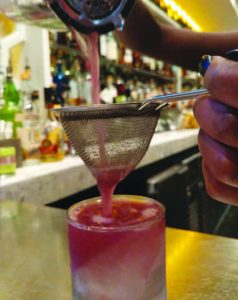 craft cocktail list sporting drinks named to prompt smiles and even giggles. Lavender Holyfield? Laird’s Gin, St. Germaine, fresh lemon juice, and a simple syrup scented with blueberries and lavender. Fallen Angel stars Angel’s Envy and a supporting cast of cold-weather add-ins. You can get a Who Killed Roger Rabbit, with Bulleit Bourbon, carrot juice, ginger beer and a bolt of thyme-infused simple syrup, or down Brunch on the Lower East Side without missing a trend: house-made bacon-infused bourbon, Knob Creek Smoked Maple Bourbon, vermouth and orange bitters. Catch the scene? You are supposed to have fun here.
craft cocktail list sporting drinks named to prompt smiles and even giggles. Lavender Holyfield? Laird’s Gin, St. Germaine, fresh lemon juice, and a simple syrup scented with blueberries and lavender. Fallen Angel stars Angel’s Envy and a supporting cast of cold-weather add-ins. You can get a Who Killed Roger Rabbit, with Bulleit Bourbon, carrot juice, ginger beer and a bolt of thyme-infused simple syrup, or down Brunch on the Lower East Side without missing a trend: house-made bacon-infused bourbon, Knob Creek Smoked Maple Bourbon, vermouth and orange bitters. Catch the scene? You are supposed to have fun here.
We did. How could we not, with a platter of Tennessee-style “prosciutto,” a thick-cut ham with layers of smoke and a mere suspicion of sweet sitting in front of us. The plate was perfectly partnered with mild whipped ricotta, a mound of olive tapenade, and a splay of old-fashioned health salad that shouted Jewish deli circa 1960. Speaking of crunch, the pickled daikon radish and cukes gave backbone to the Vietnamese-style steamed buns, filled with pork belly and given a wash of hoisin sauce. The much-anticipated roasted lamb belly was the first-round standout, a yin-yang of tenderness of texture and strength of seasoning. You’re given much to play with on this plate, including lemon-licked yogurt that gave Middle Eastern nuance to the lamb, mint, and cranberries that offered throwback accenting tastes, and shavings of zucchini that provided a kind of palate cleanse between the variously spiced bites. Good stuff.
yogurt that gave Middle Eastern nuance to the lamb, mint, and cranberries that offered throwback accenting tastes, and shavings of zucchini that provided a kind of palate cleanse between the variously spiced bites. Good stuff.
Skip the eggplant “meatballs,” which have a glutinous mouth-feel that clashes with the ricotta, tomato sauce, and olives co-habiting the plate. Better in the vegetable-strong segment of starters: the kimchi fried rice, which has a roster of produce within that could nourish a family of six for a week, and Kung Pao cauliflower, which marries the current craze of cauliflower-cauliflower-everywhere (and every way) with the ubiquitous sweet-sour sauce found in zillions of strip-mall Chinese dishes. Only INC does it better: The sauce doesn’t even approach cloying; sour and a touch of tart makes it feisty, punching up the cruciferous vegetable.
By the time our entrees were arriving, INC had started to swing. There were couples at high-top tables, folks lounging around the regular dining tables and a lively bar scene. The space that once was home to Daryl, a wine bar that made a splash years back, sits astride the Heldrich Hotel in the heart of the downtown district. It was revamped and re-imagined by Mark Farro, who also owns Uproot in Warren, and his chef, Ryan Anderson, early in 2016. So far, in a competitive restaurant city, it’s holding its own.
 It should, if the Bacon Bolognese continues on the menu. It’s a kind of make-it-yourself carbonara, with a perfectly poached egg sitting atop peppery cavatelli tossed with applewood smoked bacon, tomato, and mozzarella. Prick the egg, let it run into the rest, toss (and toss some more), and you have a pasta dish for the ages. We liked it far better than the bland shrimp and grits, which had little presence of either the billed smoked cheddar or the lemon-garlic butter. Roasted Scottish salmon is the better choice in seafood, with a hot-sour broth fueled by tamarind and a stir-fry of tannic spinach that provided a counterpoint to the rich fish. A nightly special of steak tips plied with lemongrass didn’t make the point of why the beef needed that particular accent; it’s a dish that needs work. But Texas barbecue-style brisket? Sure thing. Belly up to that plate, complete with a Thanksgiving-ready creamy green bean-corn casserole and a splay of long-simmered onions.
It should, if the Bacon Bolognese continues on the menu. It’s a kind of make-it-yourself carbonara, with a perfectly poached egg sitting atop peppery cavatelli tossed with applewood smoked bacon, tomato, and mozzarella. Prick the egg, let it run into the rest, toss (and toss some more), and you have a pasta dish for the ages. We liked it far better than the bland shrimp and grits, which had little presence of either the billed smoked cheddar or the lemon-garlic butter. Roasted Scottish salmon is the better choice in seafood, with a hot-sour broth fueled by tamarind and a stir-fry of tannic spinach that provided a counterpoint to the rich fish. A nightly special of steak tips plied with lemongrass didn’t make the point of why the beef needed that particular accent; it’s a dish that needs work. But Texas barbecue-style brisket? Sure thing. Belly up to that plate, complete with a Thanksgiving-ready creamy green bean-corn casserole and a splay of long-simmered onions.
When you’re having fun, dessert’s a natural. What do you expect at a place designed around fun other than a sweet called “Milk ‘n’ Cookies”? It’s a layering of the stated elements, with cream and crunch and nibbles of chocolate. Everything nice. I kept at it, trading off bites with a whiskey’d chocolate fudge and a silky lemon custard with just the right pop of zesty citrus. Cheesecake, though nicely made, was the lackluster also-ran.
INC is where you go when the doldrums strike, and you want a little lift. It’s where you go when you’re with a crowd of friends who can’t agree on one type of cuisine and want congeniality, not conflict. It’s where you go when life’s presented you with a pickle of a problem, and you crave a jar of spicy spears to solve it.
WHISKEY. GO. GO.
 INC has a multi-page whiskey menu that is presented at the start of a meal. The time it could take to digest this whiskey bill of fare might prevent you from actually dining, but it is a major attraction for whiskey lovers. Take the Manager’s Reserve List: There’s Corsets, Whips and Whiskey, Elijah Craig Barrel Proof, and Noah’s Mill. You also can do whiskey flights: Where There’s Smoke There’s Islay Scotch, Rye Not? and In ‘Bond’ We Trust. It’s all in good fun.
INC has a multi-page whiskey menu that is presented at the start of a meal. The time it could take to digest this whiskey bill of fare might prevent you from actually dining, but it is a major attraction for whiskey lovers. Take the Manager’s Reserve List: There’s Corsets, Whips and Whiskey, Elijah Craig Barrel Proof, and Noah’s Mill. You also can do whiskey flights: Where There’s Smoke There’s Islay Scotch, Rye Not? and In ‘Bond’ We Trust. It’s all in good fun.

Photo by Mindy Tucker
There’s something inherently funny about New Jersey. If you live here, you know what comic Mike Recine is talking about. Not the tired, old “Jersey jokes” other comics like to tell. It’s more of an inside-out point of view—a winking, hardscrabble ethos that blends sly finesse with all the subtlety of a punch in the forehead. Recine, born and bred in Hamilton, is a leading light in the next generation of Jersey stand-ups. With a pair of recent Conan appearances under his belt and his own Comedy Central special this past fall, he is poised to write a new chapter in the story of New Jersey comedy. But then, writing has always come easily to Mike. As he told EDGE editor Mark Stewart, it’s performing where he’s had to pay his dues.
EDGE: What is something about being a successful comedian that audiences might not fully appreciate?
MR: That there are two parts to being a stand-up: writing and performing. You can write great jokes but if you don’t sell them—if you’re not confident and have a funny presence—people won’t want to listen to you and there will always be something missing. Writing jokes has always come easily to me. Performing is something that took a lot of work. You need to develop confidence, stage presence and timing.
EDGE: How does that evolve?
MR: There is definitely a specific rhythm you have to learn to do stand-up. You develop that by watching some of the great comics—people like Seinfeld or Louie C.K. or Woody Allen, the great joke-writers. And you watch shows like The Simpsons. The writing on The Simpsons has some of the best comedic timing. In the end, you try to be honest but you also want to make sure that your delivery is interesting and people actually want to listen to your stories. The most important thing is to meet your own standards, to write something you think is funny, jokes you care about. You want to stay relevant and have an idea of what’s going on in popular culture. A big part of being a comic is absorbing the world around you and figuring out your take on it.
EDGE: Are there times when you write something you believe has great potential, but you just can’t quite get it right?
MR: Yes. For some reason it doesn’t work on stage, so I have to just let it go.
EDGE: When was your first time doing comedy in front of an audience?
MR: I was 15 at a Panera Bread “Open Mike” night. I went with a friend from high school. I was supposed to do five minutes. I think I did about three minutes. I was nervous but it was fun. I continued doing stand-up in high school and then, as a freshman at Montclair State, I made my first appearance at Rascals in Montclair on a New Talent night, where if you bring in a certain amount of people they’ll let you perform. No one is good at comedy at that point, but if you bring enough friends they’ll give you stage time. Then, after a couple of months, your friends get sick of you…and the two-drink minimums.
EDGE: You were in the Theater program at Montclair State.
MR: For two years. Then I decided it was time to go to the city and begin my stand-up career. My first job was as a doorman at Carolines. I did that for three months. I was 20 and got to know a lot of comics as they went in and out—a lot of comedians who were farther along in their careers than I was. Julian McCullough—another Jersey guy who lives in LA right now—and Mike Vecchione were some of the guys who were generous with advice. The experience at Carolines helped me understand the business and get a sense of the career path of a stand-up comic. But obviously I was working the door at night. I realized that if I was going to be serious about this I had to get a day job

Conaco LLC
so I could be free to perform.
EDGE: What kind of work did you do?
MR: I did everything. I wore a sandwich board in Times Square. I was a mover. I worked for 1-800-GOT-JUNK. I had restaurant jobs. And I was doing some freelance writing. All those jobs, though, helped me shape my perspective and figure out what I wanted to say. A lot of times, with younger stand-ups, they try to be comics before they learn how to be people. That was me. I started in comedy before I knew who I was as a person. When anyone asks my advice I tell them “Don’t be in a rush.” Every day you learn something new about human nature.
 EDGE: What, for you, was a big breakthrough moment? When did you cross a threshold in this business?
EDGE: What, for you, was a big breakthrough moment? When did you cross a threshold in this business?
MR: The first time I did Conan, in 2014. That was pretty cool. Every young comic is always trying to get on television. That first time on Conan was a big deal. That was the late-night show I’d always wanted to do, the show I’d watched growing up. It elevated me to that next level. That type of appearance legitimizes you and you feel like Okay I did this…there’s evidence I was here, even if it’s the only thing I ever do. I did another appearance on Conan in 2016.
EDGE: And the next level from there?
MR: The half-hour Comedy Central special last October 7th. Once you’ve done that, it’s easier to headline on the road.
EDGE: How does having your own comedy special change things?
MR: It’s funny. From a career perspective, the more you accomplish, the more you’re chasing the next thing, whatever that is. You do have that high for a couple of days. After the first Conan, I thought the set went really well. It was exciting going to the studio and preparing…it was a big deal. The second time you’re on TV it feels more like business as usual.
EDGE: You grew up in Hamilton. What was it about the Recine family culture that produced a comic?
MR: Both my grandfathers were very funny, but I was a quiet, introspective kid. My family members were very honest with one another, never afraid to say what they were thinking.
EDGE: Who made you smile growing up?
MR: Mel Brooks. As a kid I watched History of the World Part I and Blazing Saddles, and that was what made me think I really wanted to do comedy. I wanted to write it. I wanted to produce it. I wanted to get really good at it. I wanted to make people laugh.
EDGE: So why standup?
MR: I feel like it was because it is something you do alone. You don’t have to depend on other people. I guess that fit my personality.

Jon Asher
EDGE: Which stand-ups did you admire?
MR: I watched a lot of Comedy Central specials and listened to a lot of albums. Rodney Dangerfield, Mitch Hedberg, Dave Attell, Greg Giraldo. I watched Colin Quinn’s show, Tough Crowd. Every stand-up will tell you that was such a great setting and such a great way to present comics being naturally funny, off-the-cuff. Now you can see all the episodes on YouTube.
EDGE: Growing up in Jersey and now having lived in Brooklyn for a number of years, has that helped to define your style?
MR: Yeah. I’ve always been kind of an East Coast guy. I’ve always been drawn to blue-collar people and the way they are funny. There’s something about Jersey’s angry, working-class culture where they can be mean to each other but in a humorous way. It’s weird, though—I’ll be working in Manhattan or Brooklyn, where the room is full of “transplants” who’ve seen a couple of episodes of Girls and feel they know what it is to live in New York, but I can tell they lack that working-class sensibility.
EDGE: How does your act play on the road?
MR: Audiences are different wherever you go. A comic should be able to do well in every room. I’ve had good shows in Boston and Philadelphia, but also in Florida and Portland, Oregon. I did a few dive-y bar shows in Portland last year and those went really well. There’s always a way to connect with people.
EDGE: Great comics talk about what they know…and invariably they bring some aspect of their family into their act. In your case, one of your brothers is autistic.
MR: Yes.
EDGE: You tell some very funny stories that involve him in your act. Is that fair territory?
MR: I think it is. There are a lot of people who have special-needs people in their families. It’s actually fun to do that material and to connect with those people on that level. But you’re right, it’s not something you see a lot of comics talking about. It just happens to be very real to me. I think about it. I explore it. I examine it. Like my autistic brother does Special Olympics every year, and one year he got disqualified from a race. That’s a thing they do to Special Olympic athletes. Someone had to blow a whistle in his face and be like, Get out of here—you’re done! The reason he got disqualified is that he was in a walking race…and he ran. He was reprimanded for that. Does that make any sense? He didn’t ruin Christmas. Or squeeze a puppy too hard. He figured out how to win a race. With his mind.
EDGE: And the rest of your family’s fair game…
MR: Yeah, so I have another brother who’s not autistic and a friend of mine met that brother recently. He knew I had an autistic brother and he said to me, “Mike, I just met your brother and he’s barely autistic.” I think that’s a funny thing to learn about yourself: You’re not autistic but people think you are. You need to stop blinking so much…and stop wearing that propeller hat everywhere!
Editor’s Note: Mike Recine will be appearing at Catch a Rising Star in Princeton on March 31st and April 1st. He performs in New York City almost every night. You can find his schedule at mikerecine.com.








